The best microphones for voice recording 2015
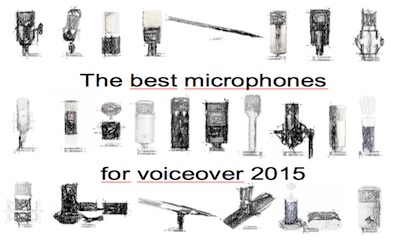
After intensive research here come our new article with over 60 microphones for Voice Over. Click here:
Content
1. Introduction
2. Types of microphone and characteristics
3. Making the right choice
4. 60 Voice-over Microphones in comparison
4.1. Price category up to 500 USD
4.2. Price category up to 1,000 USD
4.3. Price category up to 1,500 USD
4.4. Price category up to 2,000 USD
4.5. Price category up to 3,000 USD
4.6. Price category up to 5,000 USD
4.7. Price category up to 10,000 USD
1. Introduction
Anyone who deals with voice recording and technical matters in the studio on a daily basis soon notices how the smallest differences in polar pattern or the signal to noise ratio of microphones can give quite different results in quality. A microphone suitable for voice-overs is not necessarily also suitable for film dubbing.
But what characteristics can tell us which microphone can best be used for which purpose?
Following is our overview for you of the most important microphones, getting at the differences and microphone-specific advantages and disadvantages inherent in their characteristic features.
In order to do this, we would like to begin by explaining the fundamentals of the different types of microphone. The best known is the large-diaphragm condenser microphone, which nowadays has a place in every professional recording studio. It differs in the way it transforms audio pressure from the dynamic microphone, which should also under no circumstances be omitted with reference to recordings of speech.
2. Types of microphone and characteristics
The condenser microphone
The condenser microphone is sub-divided into two categories: the small-diaphragm and the large-diaphragm condenser microphone. Small-diaphragm microphones are usually cigar-shaped and are spoken into from the front, while, by contrast, large-diaphragm microphones are made significantly wider and are spoken into almost exclusively from the side. Both are equipped with a light diaphragm, which can pick up fast signal impulses easily. Condenser microphones therefore have a sound which is transparent and rich in detail.
Not everybody knows that small-diaphragm microphones can record frequencies just as low as large-diaphragm microphones. Most large-diaphragm microphones can also be used for higher frequencies as well as small-diaphragm microphones. Condenser microphones in general have a very wide range, most of them covering the full audible spectrum.
The size of the diaphragm plays an important role in the polar pattern; with large-diaphragm microphones the recording field is narrower for high frequencies. In practice, this means that signals that reach the diaphragm directly from the front („on axis“) sound richer in trebles than sound sources positioned to the side („off axis“). Apart from that, large diaphragms have a unit impulse response very slightly inferior to that of small diaphragms, which are able to follow the sound waves more precisely because of their slighter bulk.
There is, however, one significant advantage that the large-diaphragm microphone enjoys over the small-diaphragm microphone: it is lower noise. Because of its larger diaphragm area, the large-diaphragm microphone has a stronger desired signal, resulting in a better signal to noise ratio. A characteristic of large-diaphragm microphones is that they present sounds – especially the human voice – as fuller and more substantial than they are in reality. „Larger than life“ is one way of putting it. And that's the sound we all want!
The first large-diaphragm microphones were all equipped with tube electronics. The smooth mellowness of the tube sound is, in a way, the large diaphragm's crowning glory. The slightly overmodulated performance of tube circuits produces overtones and enables the signal to appear denser and more „interesting“. Caution is, however, advised. A more natural sound is often desired for voice recordings and this can more easily be achieved using a large-diaphragm microphone with transistor circuitry.
Large-diaphragm condenser microphones are available with fixed or variable polar patterns. Models with a fixed polar pattern almost always have cardioid polar patterns, which is very useful for voice recording.
With the cardioid feature, sound coming from the front is recorded louder than that from the side. The cardioid is least sensitive for sound coming from behind. In voice recordings one normally aims for a very direct sounding signal; a more ambient sound is usually not desired. The cardioid feature, with which sound reflections from the rear and the sides are not captured, approaches this audio ideal.
The condenser microphone usually has an active amplification circuit, requiring a supply of current. This is often provided by the so-called 48-volt phantom power of the microphone's preamp.
Shotgun microphones
Shotgun microphones are part of the standard equipment of film shoots. When the microphone should not be seen in the frame, one works with the microphone at a greater distance. Shotgun microphones are effective for this with their very narrow recording fields and simultaneous suppression of sound from the sides.
Shotgun microphones have, however, a very strong close-talking effect. A reasonably linear recording requires a certain distance from the microphone. Shotgun microphones are thus not very useful for classic voice-over recordings. But on a film set, it is often not the optimal sound that is being targeted, necessitating post-synchonization. In ADR, the shotgun microphone is also indispensable in the studio, in order to preserve the typical on-set quality of the sound. Beyond that, it is perfectly suited to the recording of radio plays or computer games, which normally also aim for a more natural sound.
Shotgun microphones are usually condenser microphones and therefore require current in the form of phantom power via the preamp. Some shotgun microphones can also be operated with battery power, especially those designed for use with video cameras.
Dynamic microphones
A dynamic microphone is an electro-acoustic converter, which transforms waves of acoustic sound as faithfully as possible, first into mechanical vibrations and then into electrical waves. The way in which a dynamic microphone functions is based on the principle of induction, in accordance with which an electrical conductor moving in a magnetic field produces a current. This conductor can also be at the same time the microphone diaphragm (ribbon microphone) or be affixed as a coil to the diaphragm (moving coil microphone).
Moving coil microphones
In a moving coil microphone a movable induction coil attached to the microphone diaphragm is positioned in the circular field of a magnet. When the diaphragm vibrates, a current is produced in the coil that can be picked up without a repeating coil, as the coil's resistance is already at about 200 ohms. Compared to a condenser or ribbon microphone, the moving coil microphone lacks a linear frequency response characteristic, making it extremely difficult to keep the complete frequency range linear. The unit impulse response is also not optimal, due to the relatively large mass of the diaphragm.
Despite these limitations, high grade moving coil microphones offer good sound quality and are also used a great deal in studios. One finds them used on the stage even more often. They are more robust than condenser microphones and perform without distortion even at high sound levels. As the moving coil microphone in any case lacks a linear frequency response characteristic, many manufacturers try to influence the frequency response in such a way that a microphone is especially well adapted for a particular task. Thus, in recent years, a couple of moving coil microphones have emerged that have marked the typical sound of the radio announcer.
Ribbon microphones
The diaphragm of a ribbon microphone is an aluminum ribbon from two to four millimeters wide and one centimeter long. This ribbon is suspended between the two poles of a magnet and is only capable of minimal vibration. Ribbon microphones generally have a linear frequency response characteristic and, due to their light diaphragm, have a good unit impulse response. This enables the ribbon microphone to engage in definite competition with the condenser microphone. It is sensitive to wind, shock and fast movements. As ribbon microphones are generally quieter than other microphones, they require a low noise preamp with high gain in order to achieve a usable sound for post-production.
The ribbon microphone is designed as what is known as a pressure-gradient microphone. In this design the capsule is open at the back. The „natural“ polar pattern of the ribbon element is therefore a figure of eight. This means that it reacts identically to sound from both the back and the front. This can be a drawback, depending on the space, as it takes in much more space than the cardioid variation. An example of a useful function of the figure of eight characteristic is in an interview situation. A ribbon microphone can be positioned between two speakers in such a way as to record both speakers with only one microphone.
As a result of the figure of eight charactistic, most ribbon microphones display a very strong tendency towards a close-talking effect, i.e. with a small distance from the microphone there is a marked increase in bass. This permits voices to sound sonorous, large and full. For precisely this reason, ribbon microphones are very popular with American radio announcers. Those for whom the typical polar pattern is not beneficial can nowadays avail themselves of a number of ribbon microphones with different polar patterns.
Ribbon microphones sound full, round and pleasantly soft. They give a more detailed recording than other dynamic microphones but are also smoother in higher ranges than condenser microphones. Ribbon microphones provide the human voice with magnitude and velvet elegance and are therefore highly suitable for song and speech. It is precisely those voices which tend to harshness which can benefit from the ribbon sound. Most ribbon microphones are, in addition, relatively unproblematic when it comes to sibilants.
A peculiarity – the pressure-gradient microphone
The pressure-gradient microphone is not really a microphone type of its own. It is more correctly viewed as a microphone with a pressure-gradient feature. With its capsule open at the back, the diaphragm is accessible to sounds coming from all sides. Depending on the type, simple pressure-gradient microphones give a polar pattern between cardioid and figure of eight. The electrical signals emitted by the pressure-gradient microphone are proportionate to the pressure-gradient. In a formal sense, all microphones other than pure pressure transducers (with an omnidirectional characteristic) are considered to be pressure-gradient transducers.
3. Making the right choice
a In view of the multitude of microphones, it is no simple matter to choose the right one. The following questions may help to narrow the choice of microphones down:
How loud should be the noise of the microphne ?
Should it sound rather natural or colored ?
Should there be a proximity effect ?
Should it be a tube sound ?
What kind of preamp and AD converter do I use for my mic ?
What`s the usage of the recording ?
Depending on the voice and the desired tone, different microphones may be in the running. There are, of course, a few all-rounders, which can be put to different uses. If you have the opportunity to obtain several microphones to test, by all means do so. Now here come our selections for the best microphones for voice recording.
4. 60 voice-over microphones in comparison
In what order would it be best to undertake the discussion of 60 microphones? We asked ourselves this question and opted to organize them according to normal market prices. Of course, we could have done it differently, for example, according to which are „best suited to male or female voices“. But, we considered that the price of a microphone is a relatively „objective“ feature, whereas the final sound recorded with it also depends on the preamp, analog-converter, general audio trends, etc.
So here we go:
A.) Price category up to 500 USD
B.) Price category up to 1,000 USD
C.) Price category up to 1,500 USD
D.) Price category up tp 2,000 USD
E.) Price category up to 3,000 USD
F.) Price category up to 5,000 USD
G.)Price category up to 10,000 USD
A.) A.) Price category up to 500 USD
Shure SM57

Type: moving coil microphone
Polar pattern: cardioid
Frequency response: 40 Hz to 15 kHz
Price: c. 110 USD

Type: moving coil microphone
Polar pattern: cardioid
Frequency response: 40 Hz to 15 kHz
Price: c. 110 USD
Both on the stage and in the studio the SM57 delivers a reliable performance.
A singular sound with unusual power in the bass and clarity.
The frequency response has been optimized to enable the voice to come through excellently in the mix without having to tamper with it at the mixing console EQ. The consistent cardioid feature makes it feedback-proof even on loud stages.
A singular sound with unusual power in the bass and clarity.
The frequency response has been optimized to enable the voice to come through excellently in the mix without having to tamper with it at the mixing console EQ. The consistent cardioid feature makes it feedback-proof even on loud stages.
Rode NT1-A
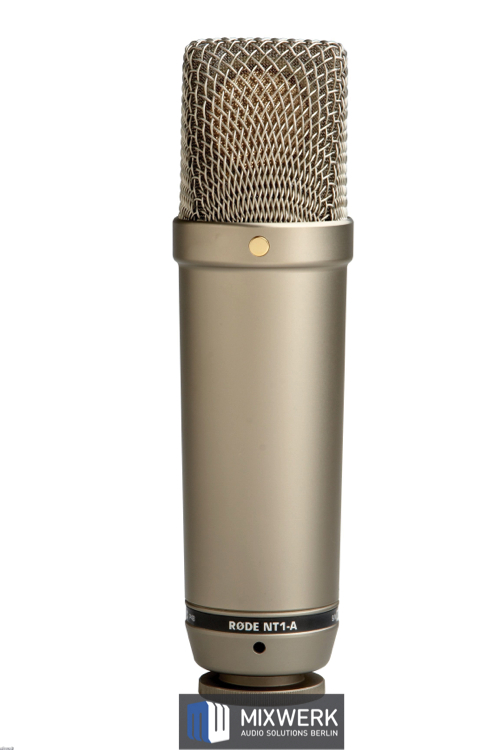
Type: large-diaphragm condenser microphone
Polar pattern: cardioid
Frequency response: 20 Hz to 20 kHz SPL max: 137 dB SPL
Self-noise level: 5dB (A)
Price: c. 180 USD

Type: large-diaphragm condenser microphone
Polar pattern: cardioid
Frequency response: 20 Hz to 20 kHz SPL max: 137 dB SPL
Self-noise level: 5dB (A)
Price: c. 180 USD
The RØDE NT1-A 1" condenser microphone has become a standard for the industry. It delivers the warmth, the great dynamic range, the clarity and the high overmodulation stability that are otherwise familiar only in microphones in higher price ranges.
With a self-noise level of only 5 db (A), it is known as one of the lowest-noise studio microphones, making it an ideal microphone for song and speech.
The large 1" capsule with a gold-plated diaphragm gives a balanced sound. Another point in its favor is the accessory pack with which the microphone is supplied.
With a self-noise level of only 5 db (A), it is known as one of the lowest-noise studio microphones, making it an ideal microphone for song and speech.
The large 1" capsule with a gold-plated diaphragm gives a balanced sound. Another point in its favor is the accessory pack with which the microphone is supplied.
Oktava MK-319
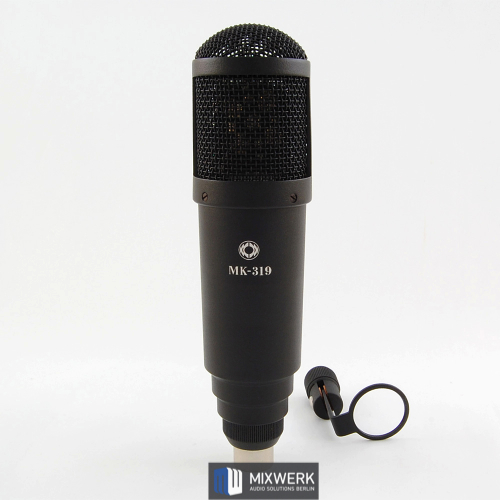
Type: large-diaphragm condenser microphone
Polar pattern: cardioid
Frequency response: 20 Hz to 18 kHz
Maximum SPL: 122 dB SPL
Self-noise level: less than 14 dB (A)
Price: c. 250 USD
The MK-319 is the successor to the MK-219 and it displays the same uncompromising love for detail, giving a larger-than-life performance in improved form. The MK-319 benefits from a new angled casing that produces a warm and open sound by minimizing sound refractions in the grille.
The microphone is fixed-pattern and is well-suited to both studio and broadcast use. The diaphragm has a gold vapor coating and its own low-noise preamp circuit. This gives a balanced frquency response from 40 Hz to 16 kHz with a slight increase in presence, which provides additional warmth and clarity to the human voice.

Type: large-diaphragm condenser microphone
Polar pattern: cardioid
Frequency response: 20 Hz to 18 kHz
Maximum SPL: 122 dB SPL
Self-noise level: less than 14 dB (A)
Price: c. 250 USD
The MK-319 is the successor to the MK-219 and it displays the same uncompromising love for detail, giving a larger-than-life performance in improved form. The MK-319 benefits from a new angled casing that produces a warm and open sound by minimizing sound refractions in the grille.
The microphone is fixed-pattern and is well-suited to both studio and broadcast use. The diaphragm has a gold vapor coating and its own low-noise preamp circuit. This gives a balanced frquency response from 40 Hz to 16 kHz with a slight increase in presence, which provides additional warmth and clarity to the human voice.
RØDE NT1000

Type: large-diaphragm condenser microphone
Polar pattern: cardioid
Frequency response: 20 Hz to 20 kHz
Maximum SPL: 140 dB SPL
Self-noise level: 6 dB (A)
Price: c. 250 USD

Type: large-diaphragm condenser microphone
Polar pattern: cardioid
Frequency response: 20 Hz to 20 kHz
Maximum SPL: 140 dB SPL
Self-noise level: 6 dB (A)
Price: c. 250 USD
The RØDE NT1000 was conceived as a typical vocal and instrumental microphone.
It wins with its clear sound and a large dynamic range achieved through workmanship of a high standard. The microphone's transformerless output circuit, together with the high quality of the pre-installed components, results in a sensationally low self-noise level.
The 1“ microphone capsule developed and produced by RØDE (HF-2) is elastically suspended, preventing to the greatest possible degree the transmission of any undesirable structural sound.
Studio Projects CS1
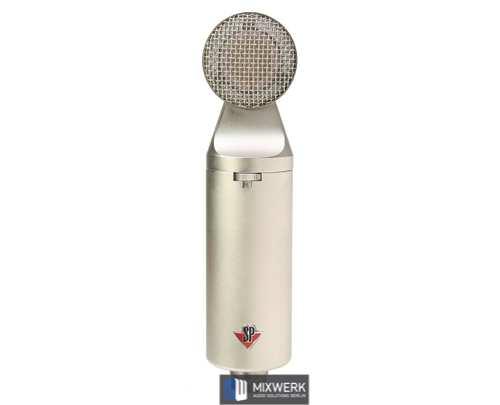
Type: large-diaphragm condenser microphone
Polar pattern: cardioid
Frequency response: 20 Hz to 20 kHz
Maximum SPL: 134 dB SPL
SNR: 84 dB (1 kHz @ 1 Pa)
Price: c. 260 USD

Type: large-diaphragm condenser microphone
Polar pattern: cardioid
Frequency response: 20 Hz to 20 kHz
Maximum SPL: 134 dB SPL
SNR: 84 dB (1 kHz @ 1 Pa)
Price: c. 260 USD
The Studio Projects CS1 is a pressure-gradient transducer with FET impedance converter.
The CS1 impresses with its tolerance of high sound levels, low self-noise and flexible deployment. It can playfully master every kind of use, from instrumental to speech and vocals
A special feature is the four-level „high cut“ filter. This enables the attenuation of the signal by 6 dB with frequency selection: 3 kHz, 7 kHz, 15 kHz.. The microphone has a cardioid polar pattern. The amp circuitry is based on a low-noise design, providing a self-noise of 10 dB A.
Cascade Elroy
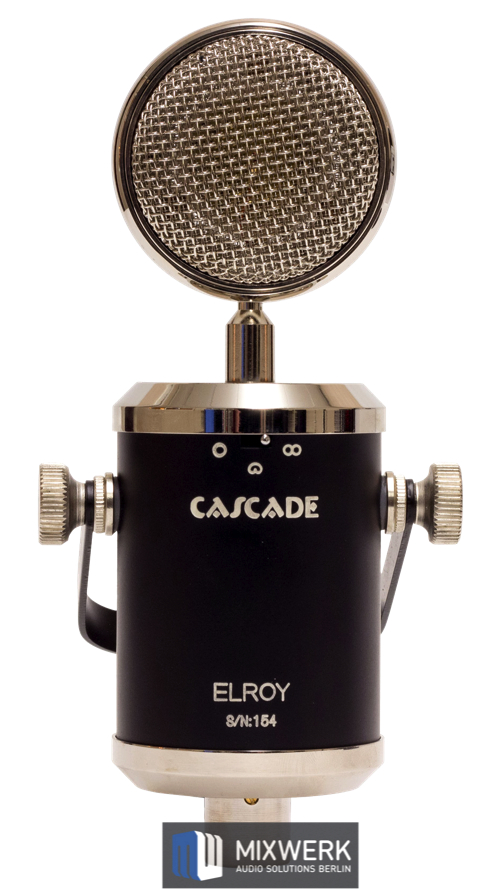
Type: large-diaphragm tube microphone
Polar pattern: variable
Frequency response: 20 Hz to 20 kHz
Maximum SPL: 133 dB SPL
Price: c. 300 USD

Type: large-diaphragm tube microphone
Polar pattern: variable
Frequency response: 20 Hz to 20 kHz
Maximum SPL: 133 dB SPL
Price: c. 300 USD
The ELROY tube microphone is equipped with a special shockproof capsule, making additional anti-shock measures redundant. The polar pattern (omnidirectional, cardioid and figure of eight) can be set at the front.
Equipped with a 6J1 tube, the ELROY provides a warm sound with very little self-noise. The large diaphragm is especially well-suited to recording all kinds of vocals, as well as brass, strings and guitars.
Beyerdynamic M99

Type: dynamic large-diaphragm microphone
Polar pattern: hypercardioid
Frequency response: 30 Hz to 18 kHz
Maximum SPL: - dB SPL
SNR: - dB (1 kHz @ 1 Pa)
Price: c. 350 USD

Type: dynamic large-diaphragm microphone
Polar pattern: hypercardioid
Frequency response: 30 Hz to 18 kHz
Maximum SPL: - dB SPL
SNR: - dB (1 kHz @ 1 Pa)
Price: c. 350 USD
The M99 is a studio quality dynamic moving coil microphone. The frequency response has been optimized for use by announcers in radio studios, as well as for instrumental recordings. The frequency response is very linear and enables a playback quality comparable with top-of-the-range condenser microphone
At the bottom of the microphone is a switching circuit enabling alternation between linear reproduction and two equalizers for specific vocal and instrumental uses. Presence can be increased with a switch, enabling a balanced sound with close-talking.
Shure SM7B
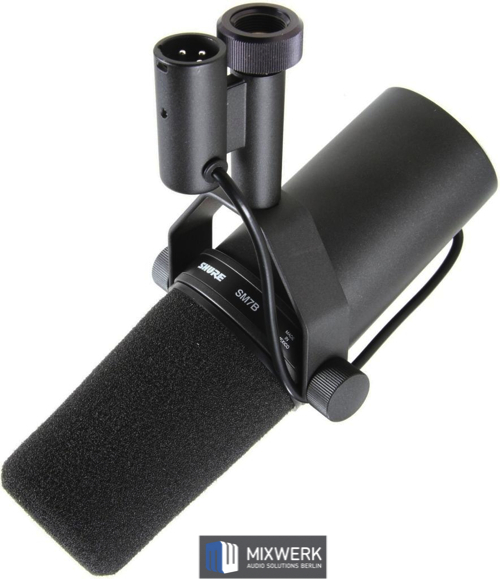
Type: dynamic microphone
Polar pattern: cardioid
Frequency response: 50 Hz to 20 kHz
Price: c. 370 USD

Type: dynamic microphone
Polar pattern: cardioid
Frequency response: 50 Hz to 20 kHz
Price: c. 370 USD
The SM7B is a cardioid dynamic microphone. It is popular for the recording of speech both in radio and sound studios. The basic sound of the SM7B is exceptionally clear, while still retaining presence and warmth. Its frequency response is very broad and can be switched if necessary. For increased presence, one only has to switch on the high-boost. Low-frequency audio disturbance can be suppressed with a low-cut switch. The SM7B is fully equipped for both the professional and the ambitious home studio. The integrated swing-mount makes precise and stable positioning possible and an air suspension shock-absorber prevents almost any mechanical sound interference.
Audio-Technica 4040SM
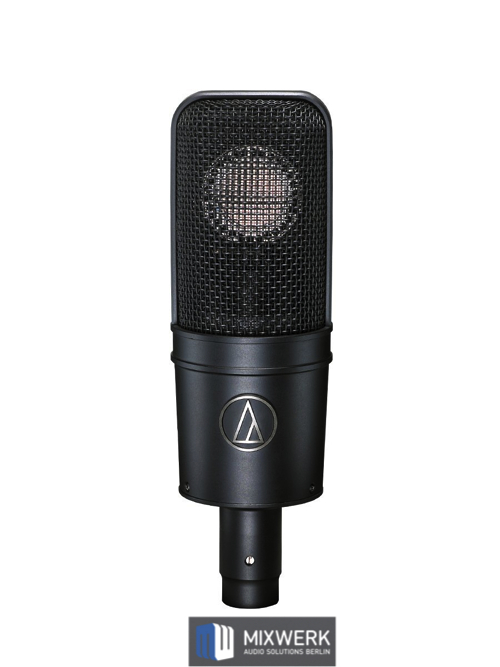
Type: large-diaphragm condenser microphone
Polar pattern: cardioid
Frequency response: 20 Hz to 20 kHz
Maximum SPL: 145/155 dB SPL
SNR: 82 dB (1 kHz @ 1 Pa)
Price: c. 380 USD

Type: large-diaphragm condenser microphone
Polar pattern: cardioid
Frequency response: 20 Hz to 20 kHz
Maximum SPL: 145/155 dB SPL
SNR: 82 dB (1 kHz @ 1 Pa)
Price: c. 380 USD
The 4040SM is a neutral-sounding microphone with a cardioid polar pattern, similar to the AKG C 214. It has high sound-level tolerance and a moderate signal to noise ratio. The 4040SM is one of the more popular microphones used at the Mixwerk studio.
AKG C 214

Type: large-diaphragm condenser microphone
Polar pattern: cardioid
Frequency response: 20 Hz to 20 kHz
Maximum SPL: 147/156 dB SPL
SNR: 81 dB (1 kHz @ 1 Pa)
Price: c. 390 USD

Type: large-diaphragm condenser microphone
Polar pattern: cardioid
Frequency response: 20 Hz to 20 kHz
Maximum SPL: 147/156 dB SPL
SNR: 81 dB (1 kHz @ 1 Pa)
Price: c. 390 USD
The AKG C 214 is in a way the little brother of the C414 XLII. The sound of both microphones is almost identical. The corner that has been cut with the C 214 is the absence of a variable polar pattern. The microphone is well-suited to both male and female voices and has a balanced sound. Due to its high signal to noise ratio, the C 214 is a real favorite for voice recordings.
Heil PR-40
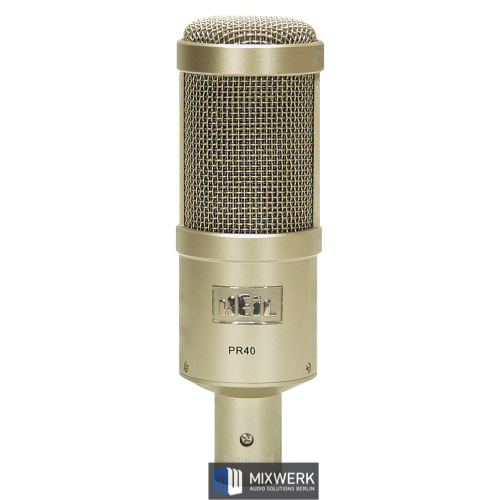
Type: large-diaphragm microphone (dynamic)
Polar pattern: cardioid
Frequency response: 28 Hz to 18 kHz
Maximum SPL: 148 dB SPL
SNR: dB (1 kHz @ 1 Pa)
Price: c. 400 USD

Type: large-diaphragm microphone (dynamic)
Polar pattern: cardioid
Frequency response: 28 Hz to 18 kHz
Maximum SPL: 148 dB SPL
SNR: dB (1 kHz @ 1 Pa)
Price: c. 400 USD
The Heil PR 40 has a very wide frrquency range for a dynamic microphone. This is the result of a large 1.5“ diaphragm with minimal mass and customized magnetic metals which are built into the solid body of the microphone. The diaphragm is elastically suspended and thus decoupled from the body. It reacts excellently to the human voice and does so across the entire spectrum of frequencies. The integrated „breath-blast“ filter reliably eliminates popping sounds.
The frequency response of the PR-40 is designed almost exclusively for vocals and speech and in most cases this obviates the need for any subsequent processing. Particularly deep voices benefit from this microphone's nice low-end.
Lewitt LCT 540

Type: large-diaphragm condenser microphone
Polar pattern: cardioid
Frequency response: 20 Hz to 20 kHz
Maximum SPL: 163 dB SPL
SNR: 86 dB (1 kHz @ 1 Pa)
Price: c. 400 USD

Type: large-diaphragm condenser microphone
Polar pattern: cardioid
Frequency response: 20 Hz to 20 kHz
Maximum SPL: 163 dB SPL
SNR: 86 dB (1 kHz @ 1 Pa)
Price: c. 400 USD
The LCT 540 brings together all the technical and acoustic features that voice talents and sound engineers expect in a high-quality condenser microphone: robust construction, flexible deployment, a natural sound rich in nuance. The built-in one-inch large-diaphragm capsule, enclosed by a grille of spring steel, captures nuances with high precision, while effectively minimizing ambient noise. Three-level attenuation and three high-pass filter settings can be adjusted directly at the die-cast casing. The microphone is not vulnerable to electro-magnetic radiation, due to a transformerless preamp circuit, and is therefore well-suited as a microphone for the home recording sector.
Sennheiser MD 421

Type: dynamic moving coil microphone
Polar pattern: cardioid
Frequency response: 30 Hz to 17 kHz
Price: c. 400 USD

Type: dynamic moving coil microphone
Polar pattern: cardioid
Frequency response: 30 Hz to 17 kHz
Price: c. 400 USD
The Sennheiser MD 421 is a widely used dynamic moving coil microphone with a cardioid polar pattern.
Due to its high audio standard, it can be deployed in a large variety of recording situations and in all technical spheres of sound transmission. The five-position bass switch emphasizes its qualities as an all-rounder. These encompass the field of professional sound engineering as well as that of utilization by the amateur.
With a diaphragm diameter of 27 mm, the MD 421 may be considered one of the few dynamic large-diaphragm microphones.
Electro Voice RE20

Type: large-diaphragm microphone (dynamic)
Polar pattern: cardioid
Frequency response: 45 Hz to 18 kHz
Price: c. 450 USD

Type: large-diaphragm microphone (dynamic)
Polar pattern: cardioid
Frequency response: 45 Hz to 18 kHz
Price: c. 450 USD
The RE20 is an absolute classic in the field of use for broadcast. The unusual performance of this microphone is achieved with a large Acoustalloy diaphragm combined with a low-mass aluminum moving coil. It has integrated pop-protection and is noted for its rarely encountered off-axis tinge.
With the RE20 one can record voices at very close range without having to worry about pops or excessive sibilants. The so-called variable-D technology eliminates the typical close-talking effect for the dynamic microphone. This means that very close sound sourcers can be recorded without sacrificing any clarity or definition.
B.) Price category up to 1,000 USD
Neumann BCM 705
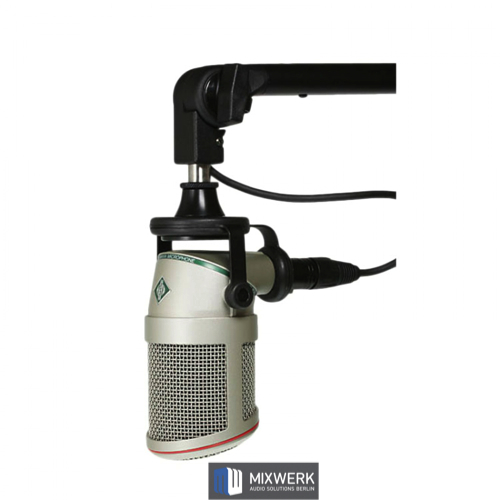
Type: dynamic microphone (pressure-gradient)
Polar pattern: hypercardioid
Frequency response: 20 Hz to 20 kHz
SNR: 76 dB (1 kHz @ 1 Pa)
Price: c. 530 USD

Type: dynamic microphone (pressure-gradient)
Polar pattern: hypercardioid
Frequency response: 20 Hz to 20 kHz
SNR: 76 dB (1 kHz @ 1 Pa)
Price: c. 530 USD
The BCM 705 is Neumann's first dynamic microphone.
The principle: reduction to the essentials – the dynamic capsule with the hypercardioid polar pattern has been conceived especially for recording speech at close range. A multi-position impact sound decoupling ensures interference-free operation, even when things are getting lively in the studio. The frequency response has a slight lift in the area crucial for clarity of speech between 2 and 9 kHz. The bass frequency response is designed to compensate for the bass lift that tends to result from close-talk.
The pop-protection is already integrated in the BCM 705 and reliably suppresses pop sounds during voice recording.
Rode K2
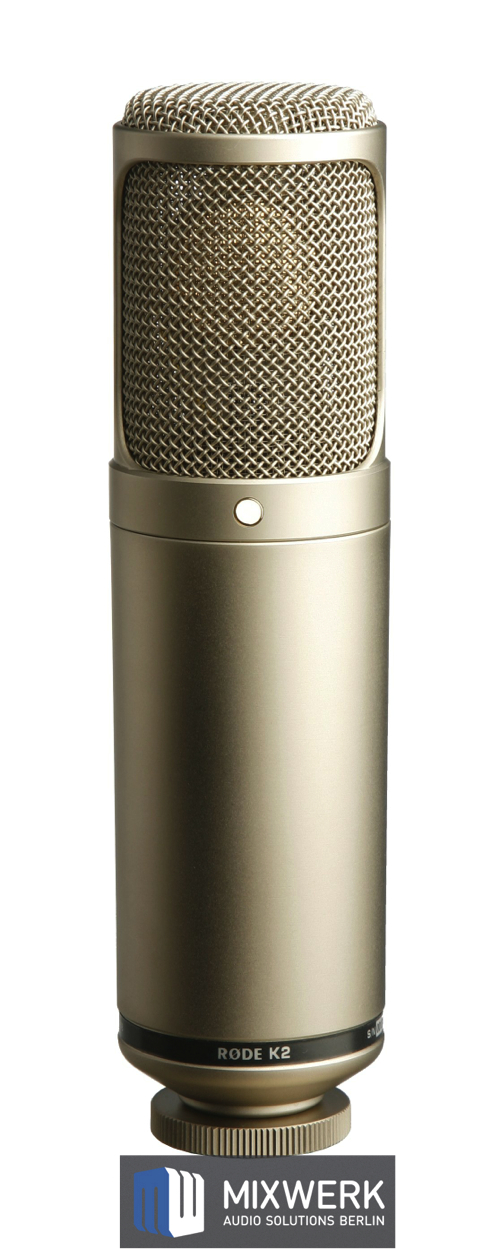
Type: tube microphone
Polar pattern: omnidirectional, cardioid, figure of eight (continuously adjustable)
Frequency response: 20 Hz to 20 kHz
Maximum SPL: 162 dB SPL
Self-noise level: 10 dB (A)
Price: c. 530 USD

Type: tube microphone
Polar pattern: omnidirectional, cardioid, figure of eight (continuously adjustable)
Frequency response: 20 Hz to 20 kHz
Maximum SPL: 162 dB SPL
Self-noise level: 10 dB (A)
Price: c. 530 USD
The original aim in developing the K2 was to construct a microphone with a typical vintage character that would nonetheless be completely up-to-date in a technical sense. The 1“ high-end HF1 capsule, together with the A-Class audiophile circuit design, enables a sensationally low self-noise level for a tube microphone.
The RØDE K2 is a premium condenser microphone with a 1“ gold-coated diaphragm. A continuous variability of the polar pattern, from omnidirectional to cardioid to figure of eight, is possible with a power supply.
The microphone is eminently suited for voice recording. In particular, the low self-noise, in combination with a balanced frequency response, makes this tube microphone a clear favorite in its price category.
Studio Projects T3
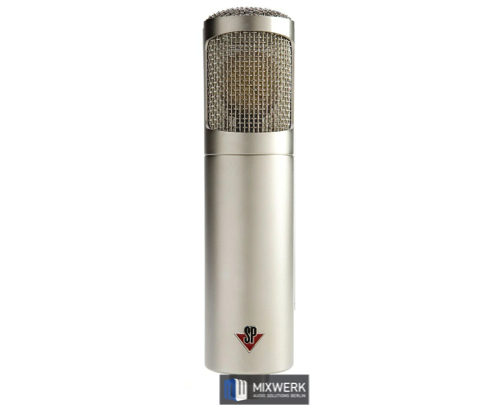
Type: large-diaphragm tube microphone
Polar pattern: variable
Frequency response: 20 Hz to 20 kHz
Maximum SPL: 125 dB SPL
SNR: 76 dB (1 kHz @ 1 Pa)
Price: c. 540 USD

Type: large-diaphragm tube microphone
Polar pattern: variable
Frequency response: 20 Hz to 20 kHz
Maximum SPL: 125 dB SPL
SNR: 76 dB (1 kHz @ 1 Pa)
Price: c. 540 USD
The Studio Projects T3 tube microphone is based on a classic 1950s design and has been refined to take advantage of all modern technical improvements. It is multifaceted in its studio use, while being a serious contender as a microphone for speech.
The Studio Projects T3 tube microphone is equipped with a double diaphragm capsule which, together with a 12AY7 (6072) triode, ensures a balanced sound. One can switch between polar patterns using a nine-position switch on the front of the power supply.
The T3's circuit design makes do with only a few components, to prevent extraneous noise and unnecessary „coloration“. The 6072 „dual triode“ vacuum tube, selected by hand, is known for inhibiting noise development and for its acoustic reliability. The T3 can thus guarantee a warm and transparent tone.
SE Electronics SE 4400A
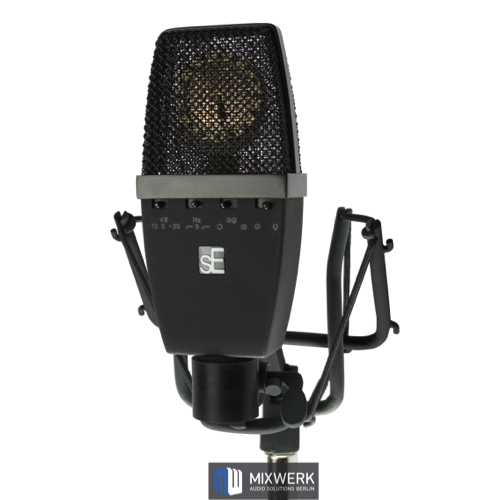
Type: large-diaphragm condenser microphone
Polar pattern: variable
Frequency response: 20 Hz to 20 kHz
Maximum SPL: 130 dB SPL
Self-noise level: 17 dB(A)
Price: c. 550 USD

Type: large-diaphragm condenser microphone
Polar pattern: variable
Frequency response: 20 Hz to 20 kHz
Maximum SPL: 130 dB SPL
Self-noise level: 17 dB(A)
Price: c. 550 USD
The SE Electronics SE-4400 A is very much an all-purpose large-diaphragm condenser microphone with excellent audio characteristics. The SE Electronics SE-4400A can handle almost every recording situation, due to the many configurations it offers, and proves itself ideal for vocals, speech and acoustic instruments.
The SE-4400A has a pleasantly natural sound. The slight treble lift provides a flattering larger-than-life vibe, but in quite a subtle way. Judicious use of the low-end can also achieve some additional warmth.
Audio-Technica 4050SM
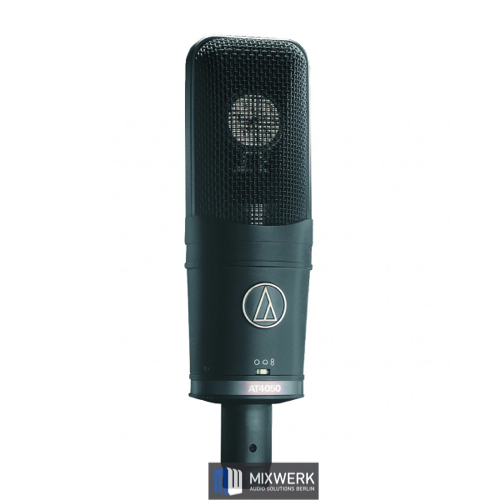
Type: large-diaphragm condenser microphone
Polar pattern: cardioid, omnidirectional and figure of eight
Frequency response: 20 Hz to 18 kHz
Maximum SPL: 149/159 dB SPL
SNR: 77 dB (1 kHz @ 1 Pa)
Price: c. 650 USD

Type: large-diaphragm condenser microphone
Polar pattern: cardioid, omnidirectional and figure of eight
Frequency response: 20 Hz to 18 kHz
Maximum SPL: 149/159 dB SPL
SNR: 77 dB (1 kHz @ 1 Pa)
Price: c. 650 USD
Transparency in the high and medium sound ranges and lush bass tones, together with highly sophisticated acoustics, provide a broad performance palette and meet the highest demands.
A transducer-free circuitry gives reproduction that is almost distortion-free at low frequencies and offers an excellent correlation of rapid transient responses.
Lauten Audio Clarion FC-357 (pressure-gradient)
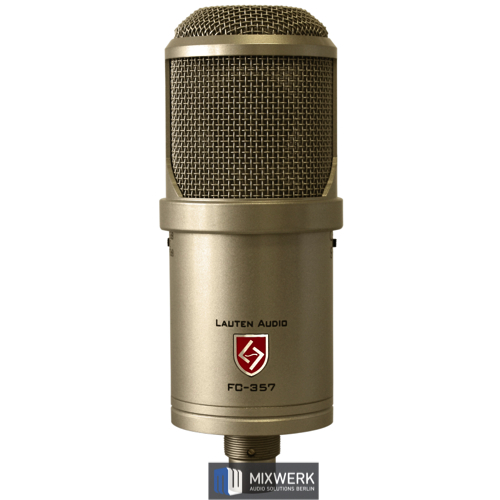
Type: FET large-diaphragm microphone
Polar pattern: variable
Frequency reponse: 25 Hz to 20 kHz
Maximum SPL: 130 dB SPL
Self-noise level: less than 10dB(A)
Price: c. 700 USD

Type: FET large-diaphragm microphone
Polar pattern: variable
Frequency reponse: 25 Hz to 20 kHz
Maximum SPL: 130 dB SPL
Self-noise level: less than 10dB(A)
Price: c. 700 USD
The Clarion provides both classic and modern FET sounds and is equipped with a customized 28.25mm dual diaphragm capsule. The electronics consist of a low-noise FET circuit and a hand-wound output transducer.
It offers a specially tuned frequency response, which gives the flowing, natural character of a classic FET condenser microphone, but is complemented with a tinge of openness, normally associated only with ribbon microphones.
Mojave Audio MA-201 FET
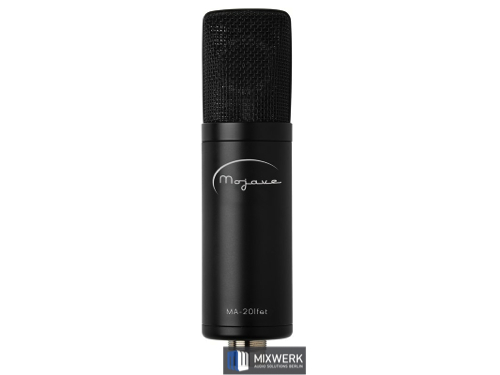
Type: condenser microphone
Polar pattern: cardioid
Frequency response: 20 Hz to 20 kHz
Maximum SPL: 125 dB SPL
Self-noise level: 14 dB (A)
Price: c. 700 USD

Type: condenser microphone
Polar pattern: cardioid
Frequency response: 20 Hz to 20 kHz
Maximum SPL: 125 dB SPL
Self-noise level: 14 dB (A)
Price: c. 700 USD
The MA-201-FET is a large-diaphragm condenser microphone with FET circuitry design. The microphone captivates with a warm and full sound that avoids sharpness in the treble range. This makes it ideally suited for recordings of speech and vocals.
High-quality components, such as a capsule with three-micron gold coating, a Jensen audio transforner and low-noise FET circuitry, all combine to put the MA-201-FET on a level with the best-loved vintage condenser microphones.
Sennheiser MD 441U
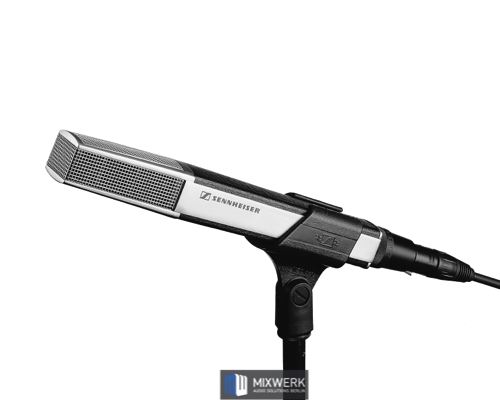
Type: dynamic microphone
Polar pattern: supercardioide
Frequency response: 30 Hz to 20 kHz
Price: c. 725 USD

Type: dynamic microphone
Polar pattern: supercardioide
Frequency response: 30 Hz to 20 kHz
Price: c. 725 USD
This high value dynamic sound converter, with acoustic characteristics almost equal to those of professional condenser microphones, wins one over with its impulse fidelity and distortion-free transmission, even at high sound pressures.
Impervious to mechanical vibrations due to its spring-suspension capsule housing, extreme feedback suppression, integrated pop screen and a five-position bass switch to compensate for close-talking – all of these balanced sound features single it out for live and reporting usage, as well as studio speech recording.
Beesneez Isobel

Type: large-diaphragm condenser microphone
Polar pattern: cardioid
Frequency response: - Hz bis - kHz
Maximum SPL:- dBSPL
SNR: - dB (1 kHz @ 1 Pa)
Price: c. 750 USD

Type: large-diaphragm condenser microphone
Polar pattern: cardioid
Frequency response: - Hz bis - kHz
Maximum SPL:- dBSPL
SNR: - dB (1 kHz @ 1 Pa)
Price: c. 750 USD
The Isobel is an FET large-diaphragm studio microphone with a fixed cardioid polar pattern. The sound is clean, realistic and surprisingly musical. Due to its low-noise circuitry, the Isobel is especially suited for the recording of voice-overs, vocals and string instruments.
Blue Microphones - Dragonfly
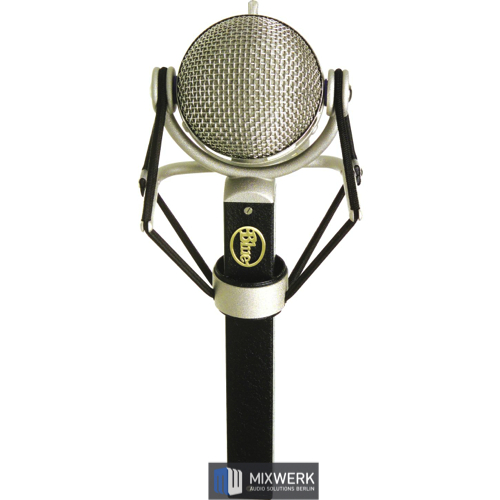
Type: pressure-gradient transducer
Polar pattern: cardioid
Frequency response: 20 Hz to 20 kHz
Maximum SPL: 132 dB SPL
SNR: 85 dB (1 kHz @ 1 Pa)
Price: c. 750 USD

Type: pressure-gradient transducer
Polar pattern: cardioid
Frequency response: 20 Hz to 20 kHz
Maximum SPL: 132 dB SPL
SNR: 85 dB (1 kHz @ 1 Pa)
Price: c. 750 USD
The Dragonfly produces silky trebles while also emphasizing lower frequencies. This helps it to give the voice a pleasant presence, openness and attractive basses. The microphone is based on a discrete Class-A circuitry with a transformerless output and gets high marks for signal to noise ratio. The Dragonfly is ideal for high frequency waves such as alto and soprano vocals, acoustic guitar, overhead percussion, electric guitar and saxophone.
Audio-Technica 4047SVSM
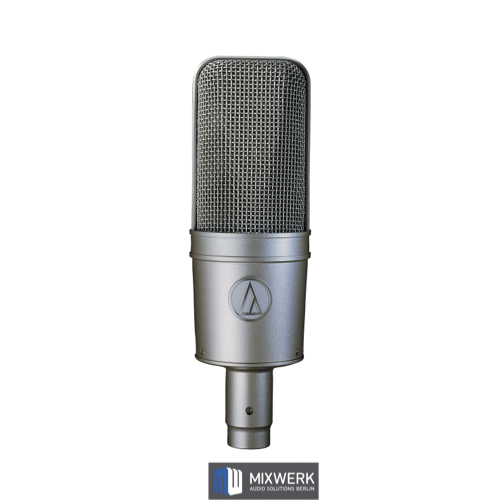
Type: large-diaphragm condenser microphone
Polar pattern: cardioid
Frequency response: 20 Hz to 18 kHz
Maximum SPL: 149/159 dB SPL
SNR: 85 dB (1 kHz @ 1 Pa)
Price: c. 800 USD

Type: large-diaphragm condenser microphone
Polar pattern: cardioid
Frequency response: 20 Hz to 18 kHz
Maximum SPL: 149/159 dB SPL
SNR: 85 dB (1 kHz @ 1 Pa)
Price: c. 800 USD
The 4047 scores high with a large dynamic range, low self-noise and high tolerance for sound levels. The warm sound of the 4047 is reminiscent of that of the first field effect transistor studio microphones. Anyone who feels the sound of the AKGs and the AT 4040 is too neutral should fall back on this microphone.
Charter Oak E700
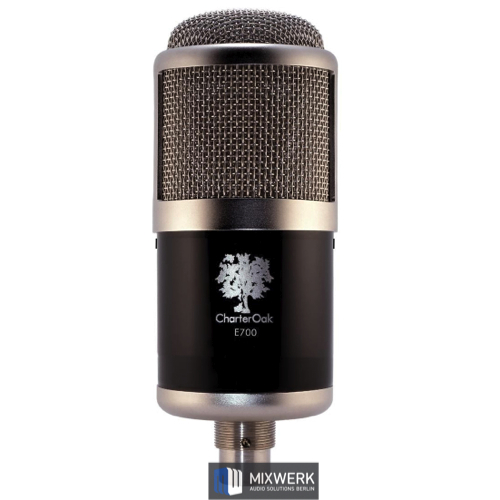
Type: pressure-gradient transducer
Polar pattern: cardioid, omnidirectional, figure of eight
Frequency response: 25 Hz to 20 kHz
Self-noise level: 17 dB “A“
Maximum SPL: 125 dB SPL
Price: c. 800 USD

Type: pressure-gradient transducer
Polar pattern: cardioid, omnidirectional, figure of eight
Frequency response: 25 Hz to 20 kHz
Self-noise level: 17 dB “A“
Maximum SPL: 125 dB SPL
Price: c. 800 USD
The Charter Oak E700 is a dual-diaphragm condenser microphone with two 1.22-inch diaphragm and discrete Class-A input amplifier electronics. The E700 was tested for years in a beta version by selected engineers and musicians and futher developed during this entire period.
The result is extremely high quality in processing and a universally applicable distinctive sound.
With its full tones, an extremely low background emission and high processing quality, this is a microphone which is extraordinarily well suited for use in broadcasting and voice-overs.
SE Electronics Z 5600A MkII
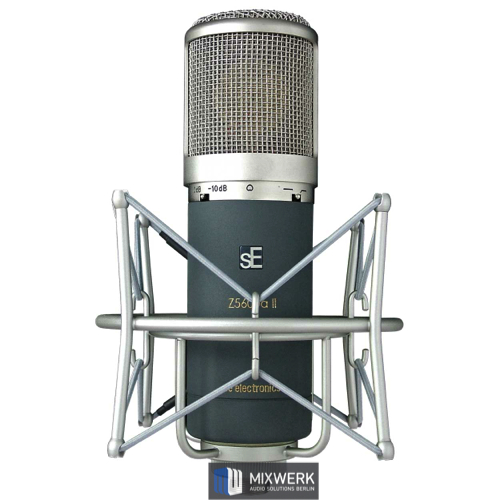
Type: tube microphone
Polar pattern: variable (9 patterns)
Frequency response: 20 Hz to 20 kHz
Maximum SPL: 135 dB SPL
Self-noise level: 12 dB (A)
Price: c. 840 USD

Type: tube microphone
Polar pattern: variable (9 patterns)
Frequency response: 20 Hz to 20 kHz
Maximum SPL: 135 dB SPL
Self-noise level: 12 dB (A)
Price: c. 840 USD
The SE Electronics Z-5600 A II is the worthy successor to the well-known Z-5600. The microphone has a 1.07“ diaphragm and a gold-coated capsule. The 12AT7 tube is replaceable.
Like its predecessor, it is suberbly adapted for use in recording vocals, speech and instrumentals, with the possibility of switching polar patterns from a choice of nine, from omnidirectional to figure of eight. Its sound is warm, precise, natural and clear – as one expects from a leader in tube microphone technology.
Neumann TLM 103
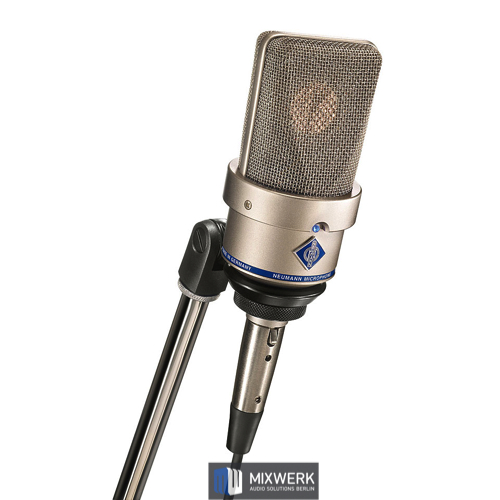
Type: large-diaphragm condenser microphone
Polar pattern: cardioid
Frequency response: 20 Hz to 20 kHz
Maximum SPL: 138 dB SPL
SNR: 87 dB (1 kHz @ 1 Pa)
Price: c. 900 USD

Type: large-diaphragm condenser microphone
Polar pattern: cardioid
Frequency response: 20 Hz to 20 kHz
Maximum SPL: 138 dB SPL
SNR: 87 dB (1 kHz @ 1 Pa)
Price: c. 900 USD
The TLM 103 is the ideal large-diaphragm microphone for anyone who doesn't want to do without professional technical quality because of budgetary limitations. It functions with a transformerless circuit of the type that has already proven itself in many Neumann microphones and offers an almost impossibly low self-noise level and the widest dynamic range.
The cardioid polar pattern capsule is particularly well-tuned for acoustic balance and good phase cancellation for sounds from the rear. The capsule has a frequency response up to about 5 kHz and also a presence lift of 4 dB. The large wire-mesh grille protects the capsule from plosives and effectively inhibits pops.
The interior design includes elastic suspension to protect from mechanical vibraton. The abbreviation TLM stand for „transformerless microphone“ and refers to the replacement of the normally used output transformer by an electronic circuit.
AKG C 414 (XLII)

Type: large-diaphragm condenser microphone
Polar pattern: multi
Frequency response: 20 Hz to 20 kHz
Maximum SPL: 140 dB SPL
SNR: 88 dB (1 kHz @ 1 Pa)
Price: c. 1,000 USD

Type: large-diaphragm condenser microphone
Polar pattern: multi
Frequency response: 20 Hz to 20 kHz
Maximum SPL: 140 dB SPL
SNR: 88 dB (1 kHz @ 1 Pa)
Price: c. 1,000 USD
The AKG C 414 is the all-rounder par excellence. It is now in its seventh generation as a classic (XLS and XLII), still without losing the typical C414 sound. What the C 414 presents is the variation optimized for vocals and speech. With an extremely high signal to noise ratio, nine polar patterns, low cut (40, 80, 160 Hz) and a light presence lift, this microphone is an ideal fit for voice recording.
Brauner Phantom C
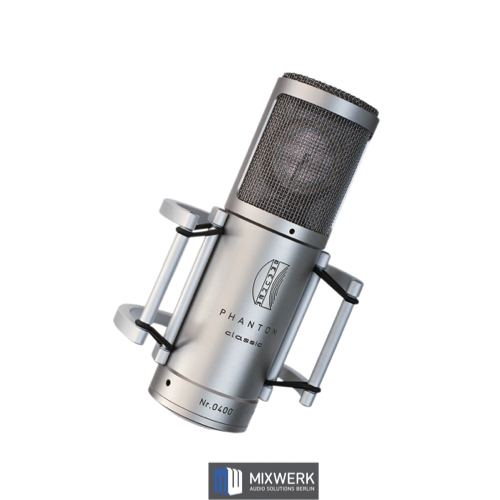
Type: pressure-gradient transducer
Polar pattern: cardioid
Frequency response: 20 Hz to 22 kHz
Maximum SPL: 142 dB SPL
SNR: 83 dB (1 kHz @ 1 Pa)
Price: c. 1,000 USD

Type: pressure-gradient transducer
Polar pattern: cardioid
Frequency response: 20 Hz to 22 kHz
Maximum SPL: 142 dB SPL
SNR: 83 dB (1 kHz @ 1 Pa)
Price: c. 1,000 USD
With its Phantom C, Brauner offers a markedly neutral-sounding microphone with a very balanced treble reproduction. The workmanship is, as with all Brauner microphones, first-class. The Phantom C can be recommended as an all-round microphone and reproduces both male and female voices with pleasing fullness.
The outstanding quality feature is that one does not hear the microphone; where other microphones either color or dilute the signal either acoustically or dynamically, the Brauner condensers remain authentic. In audio tests with other established studio microphones, the Phantom C passes with flying colors; the (perceived) linearity in frequency response and dynamics is a standard-setter – Brauner simply sounds closer to the original.
Sennheiser MKH 416
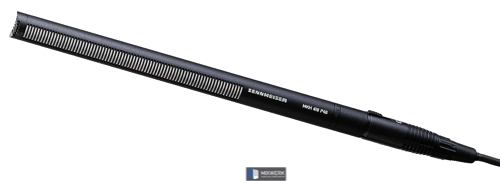
Type: condenser shotgun microphone
Polar pattern: supercardioid
Frequency response: 40 Hz to 20 kHz
Maximum SPL: 130 dB SPL
Self-noise level: 13 dB(A)
Price: c. 1,000 USD

Type: condenser shotgun microphone
Polar pattern: supercardioid
Frequency response: 40 Hz to 20 kHz
Maximum SPL: 130 dB SPL
Self-noise level: 13 dB(A)
Price: c. 1,000 USD
The MKH 416 is a short shotgun microphone. Good directivity at small dimensions, high consonant clarity and feedback prevention are the ideal requirements for its wide use in film, radio and television.
In sound studios, this microphone has set a worldwide benchmark for film dubbing work.
C.) Price category up to 1,500 USD
AEA R84
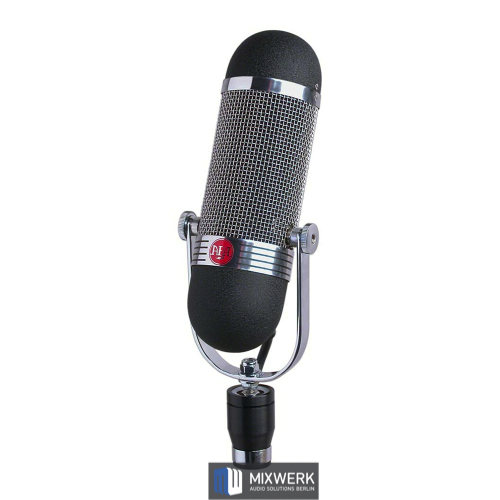
Type: ribbon/pressure-gradient microphone
Polar pattern: figure of eight
Frequency response: 20 Hz to 20 kHz
Maximum SPL: 165+ dB SPL
Price: c. 1,100 USD

Type: ribbon/pressure-gradient microphone
Polar pattern: figure of eight
Frequency response: 20 Hz to 20 kHz
Maximum SPL: 165+ dB SPL
Price: c. 1,100 USD
The AEA R84 was developed according to the basics of the R44 series. It gains points for its classic ribbon sound with a moderate close-talking effect. The microphone is suited to many uses, performing excellently in voice recordings. The ribbon element built into the R84 flatters the voice and provides a smooth and natural sound, devoid of undesirable resonances.
Microtech Gefell M 930
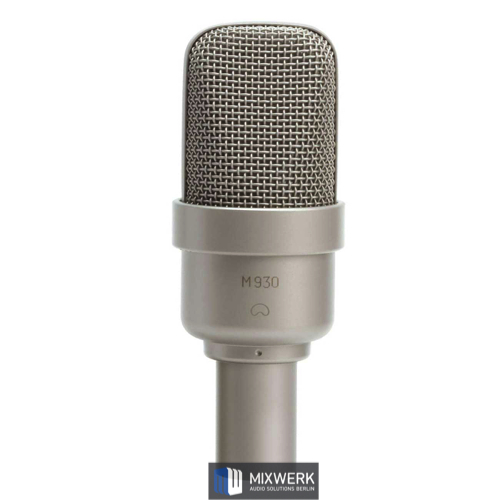
Type: condenser microphone
Polar pattern: variable
Frequency response: 40 Hz to 18 kHz
Maximum SPL: 142 dB SPL
SNR: dB 87 (1 kHz @ 1 Pa)
Price: c. 1,100 USD

Type: condenser microphone
Polar pattern: variable
Frequency response: 40 Hz to 18 kHz
Maximum SPL: 142 dB SPL
SNR: dB 87 (1 kHz @ 1 Pa)
Price: c. 1,100 USD
The M 930 is exceptionally well suited for general use in radio and sound studios, as well as in the demanding home recording area. It combines modern large-diaphragm capsule technology with the latest semi-conductor circuit technology.
The condenser microphone capsules used – cardioid, supercardioid or subcardioid – have a balanced frequency response with a light treble presence of 7 to 11 kHz and a high phase cancellation for rear and side sound incidence.
The circuit design of the impedance converter, with its expanded modulation area, makes a faithfully detailed recording of low sound levels possible, as well as distortion-free reproduction of very high sound pressure. In the microphone's compact casing, the inner workings are elastically suspended, along with the capsule, to suppress the effects of mechanical vibration and shock.
Mojave Audio MA-200 Tube Mic

Type: tube microphone
Polar pattern: cardioid
Frequency response: 20 Hz to 20 kHz
Maximum SPL: 120 dB SPL
Self-noise level: 14 dB (A)
Price c. 1,100 USD

Type: tube microphone
Polar pattern: cardioid
Frequency response: 20 Hz to 20 kHz
Maximum SPL: 120 dB SPL
Self-noise level: 14 dB (A)
Price c. 1,100 USD
The MA-200 is a large-diaphragm tube condenser microphone with a fixed polar pattern. The sound is warm and full and therefore ideal for recording speech and vocals.
The M-200 performs on the level of the best-loved vintage condenser microphones, thanks to selected components, such as the three-micron capsule, the high quality Jensen transducer and a JAN 5840 vacuum tube.
Lauten Audio Atlantis FC-387

Type: FET large-diaphragm microphone (pressure-gradient)
Polar pattern: variable
Frequency response: 20 Hz to 20 kHz
Maximum SPL: 130 dB SPL
Self-noise level: less than 12 dB(A)
Price: c. 1,200 USD

Type: FET large-diaphragm microphone (pressure-gradient)
Polar pattern: variable
Frequency response: 20 Hz to 20 kHz
Maximum SPL: 130 dB SPL
Self-noise level: less than 12 dB(A)
Price: c. 1,200 USD
The Atlantis FC-387 is a multi-pattern and multi-voicing FET large-diaphragm condenser microphone. Its sound is full and warm in the low and lower-middle frequencies and silky and balanced in the middle and higher ranges. The voicing switch makes the Atlantis a particularly versatile microphone. The modes are divided into F (forward), N (neutral) and G (gentle).
Forward offers a very open, modern and stripped sound. Neutral gives one a more even frequency response with slight lowering in the middle and higher frequencies. Gentle enables you to tame hard, bright and sibilant signal sources or produces a pleasant vintage sound.
The multi-voicing function is a great opportunity to find the best sound for each voice and situation while recording without having to change the microphone.
Microtech Gefell MT 71 S

Type: condenser microphone (pressure-gradient)
Polar pattern: cardioid
Frequency response: 40 Hz to 18 kHz
Maximum SPL: 144 dB SPL
SNR: 80 dB (1 kHz @ 1 Pa)
Price: c. 1,200 USD

Type: condenser microphone (pressure-gradient)
Polar pattern: cardioid
Frequency response: 40 Hz to 18 kHz
Maximum SPL: 144 dB SPL
SNR: 80 dB (1 kHz @ 1 Pa)
Price: c. 1,200 USD
The MT 71 S condenser microphone has a tried and true large-diaphragm capsule and is noted for its superb recording features and high sensitivity as well as a large signal to noise ratio. It guarantees a clean, untinged sound quality and is especially suited for voice recording in radio and television studios, as well as for high quality reproductions.
The frequency response of the MT 71 S is characterized by a rise of about 4 dB in the area of 7 kHz and a light drop at low frequencies.
The transformer-free circuit concept replaces the normal transducer with a symmetrical output level and guarantees a low self-noise level as well as a high capacity for modulation.
Bock U195

Type: large-diaphragm condenser microphone
Polar pattern: cardioid
Frequency response: 20 Hz to 16 kHz
Maximum SPL: 111 dB SPL “A“
SNR: 81 dB (1 kHz @ 1 Pa)
Price: c. 1,300 USD

Type: large-diaphragm condenser microphone
Polar pattern: cardioid
Frequency response: 20 Hz to 16 kHz
Maximum SPL: 111 dB SPL “A“
SNR: 81 dB (1 kHz @ 1 Pa)
Price: c. 1,300 USD
The Bock 195 is based on an FET circuit and stands out for the marked body and presence of its sound, as well as its low self-noise level, making it useful in many different situations. One can switch between „FAT“ and „norm“ modes: the FAT mode gives the microphone the typical warm tube sound by a frequency lift between 10-400 Hz. The norm mode, by contrast, sounds more neutral in the low frequency range and emphasizes the high frequencies, typical for an FET microphone. The high quality output transducer helps to round out the wonderfully analog sound of the U195.
TELEFUNKEN CU-29 Copperhead
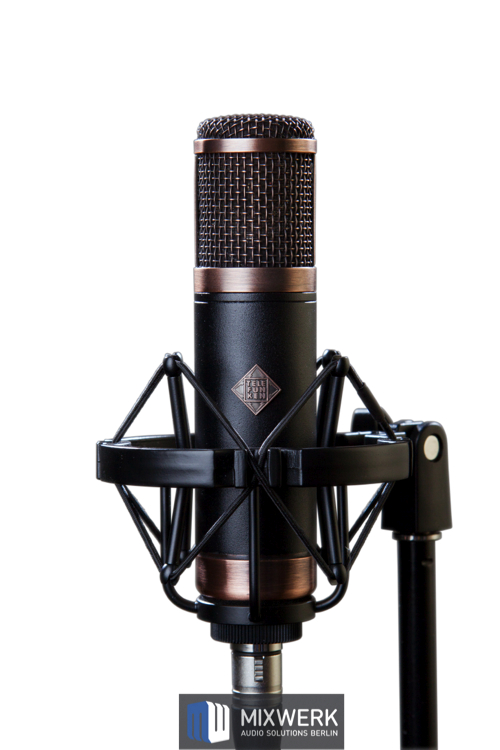
Type: large-diaphragm tube microphone
Polar pattern: cardioid
Frequency response: 20 Hz to 20 kHz
Maximum SPL: 130 dB SPL
Self-noise level: 7 dB (A))
Price: c. 1,400 USD

Type: large-diaphragm tube microphone
Polar pattern: cardioid
Frequency response: 20 Hz to 20 kHz
Maximum SPL: 130 dB SPL
Self-noise level: 7 dB (A))
Price: c. 1,400 USD
The CU-29 'Copperhead' microphone provides a warm and superbly balanced tone in the low frequency range, as well as an airy and finely tuned tone in the upper frequencies.
The R-F-T tube condenser microphone series uses electronics developed in the USA, in combination with new vintage tubes and other standardized parts from European manufacturers.
The finely tuned amplifier design in the R-F-T 'Copperhead' includes an NOS 6AK5W TELEFUNKEN tube and a Lundahl LL 1935 output transducer. As the CU-29 'Copperhead' is a pure cardioid microphone, it incorporates a one-sided diaphragm version of the large-diaphragm capsule used in the AR-51 and AK-47 MkII microphones.
To listen to, the CU-29 'Copperhead' is a notably neutral sounding microphone with a present, but by no means hard, character and a clear tone that is rich in detail. Unlike many other microphones in this price range, it is completely free of over-emphasis in the upper-middle frequency range. The microphone combines a warm and clear low frequency range with a soft and airy high frequency range.
D.) Price category up to 2,000 USD
Audio-Technica 4060A

Type: tube condenser microphone
Polar pattern: cardioid
Frequency response: 20 Hz to 20 kHz
Maximum SPL: 150 dB SPL
SNR: 75 dB (1 kHz @ 1 Pa)
Price: c. 1,600 USD

Type: tube condenser microphone
Polar pattern: cardioid
Frequency response: 20 Hz to 20 kHz
Maximum SPL: 150 dB SPL
SNR: 75 dB (1 kHz @ 1 Pa)
Price: c. 1,600 USD
Audio-Technica's AT4060a tube condenser microphone brings the warmth of the vintage tube sound into the complete tonal spectrum. With a dynamic range going beyond that of many other tube microphones, it captures the finest nuances of vocal and instrumental performance. Equipped with high quality tubes, the AT 4060a achieves the pleasant sound of classic tube circuitry.
Microtech Gefell M 1030

Type: condenser microphone
Polar pattern: cardioid
Frequency response: 40 Hz to 20 kHz
Maximum SPL: 142 dB SPL
SNR: 87 dB (1 kHz @ 1 Pa)
Price: c. 1,700 USD

Type: condenser microphone
Polar pattern: cardioid
Frequency response: 40 Hz to 20 kHz
Maximum SPL: 142 dB SPL
SNR: 87 dB (1 kHz @ 1 Pa)
Price: c. 1,700 USD
The M 1030 is especially suited for general use in broadcast and sound studios, as well as in the demanding home recording field. It combines modern large-diaphragm capsule technology with the latest semi-conductor circuitry.
The condenser microphone capsule used has a balanced frequency response with a slight high presence from 8 to 14 kHz and a high cancellation for sound emanating from the rear and sides.
The circuitry design of the impedance converter enables faithfully detailed reproduction, thanks to an expanded modulation capacity, as well as distortion-free recording of very high sound pressure.
In the compact microphone casing, the internal components, together with the capsule, are elastically suspended, to suppress mechanical vibrations and absorb shock.
Sennheiser MKH 40
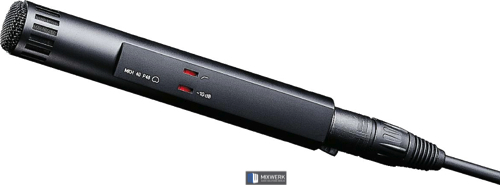
Type: condenser microphone
Polar pattern: cardioid
Frequency response: 40 Hz to 20 kHz
Maximum SPL: 134 dB SPL
Self-noise level: 12 dB (A)
Price: c. 1,800 USD

Type: condenser microphone
Polar pattern: cardioid
Frequency response: 40 Hz to 20 kHz
Maximum SPL: 134 dB SPL
Self-noise level: 12 dB (A)
Price: c. 1,800 USD
The MKH 40 can be utilized in many ways (e.g. as a main microphone) and is particularly effective in „live“ rooms or those that are in other ways acoustically less than optimal. That makes this microphone especially advantageous for recordings that take place in sound studios that have not been professionally constructed.
The polar pattern, which remains neutral in a broad range of angles, and the high rear sound suppression make for a good tonal balance.
Peluso 22 47 SE
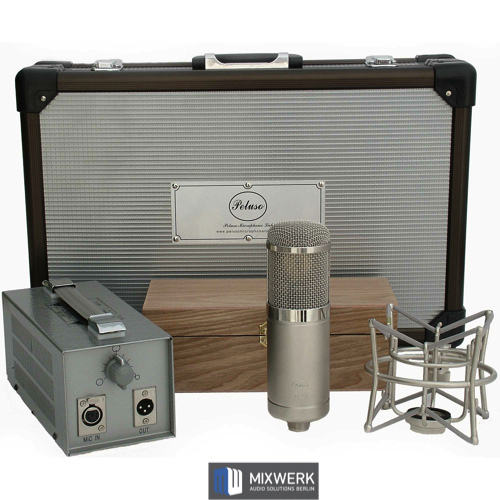
Type: tube microphone
Polar pattern: variable
Frequency response: 20 Hz to 22 kHz
Maximum SPL: 140 dB SPL
Self-noise level: 14 dB (A)
Price: c. 1,900 USD

Type: tube microphone
Polar pattern: variable
Frequency response: 20 Hz to 22 kHz
Maximum SPL: 140 dB SPL
Self-noise level: 14 dB (A)
Price: c. 1,900 USD
The Peluso 22 47 SE is a large-diaphragm condenser microphone and in its character it is derived from the legendary „Neumann U-47“.
In order to attain the unmistakable „47“ sound, the American 6SJ7 tube has been installed. This offers the same sound quality as the TELEFUNKEN VF 14 tube.
The two tubes have almost identical specifications, with the only discernible difference between them being +2 dB ambient sound for the 6SJ7.
The 6SJ7 is readily available, which means that the Peluso 22 47 Standard Edition can be offered at a very reasonable price. The microphone is suitable for both male and female voices, acoustic guitar and up to tenor saxophone. The familiar U-47 sound has an attractive warmth in low frequencies, a smooth middle range and a balanced high end. The 22 47 SE is linked with the Peluso MX-56 power supply. The double-sided capsule of the 22 47 SE enables up to 9 polar patterns, from omnidirectional to cardioid to figure of eight.
Schoeps CMIT 5 U
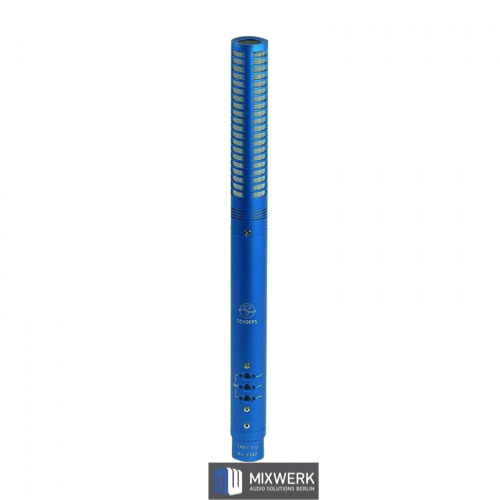
Type: condenser microphone / shotgun microphone
Polar pattern: directional (shotgun)
Frequency response: 40 Hz to 20 kHz
maximum SPL: 132 dB SPL
Self-noise level: 14 dB (A)
Price: c. 1,900 USD

Type: condenser microphone / shotgun microphone
Polar pattern: directional (shotgun)
Frequency response: 40 Hz to 20 kHz
maximum SPL: 132 dB SPL
Self-noise level: 14 dB (A)
Price: c. 1,900 USD
From the beginning, the CMIT 5 set a new standard for tube shotgun microphones. Its directionality increases especially steadily with the frequency, which gives an unusually balanced character to its sound. Apart from that, the volume level to the side of the 0°-axis decreases particularly smoothly regardless of the frequency. This enables localized sound incidents to be recorded with a neutral tone, making small errors in the angle of the microphone negligible in their effect. The directionality of the CMIT 5 is beyond what one would expect of a microphone of its length. It is also deployed in musical recordings, such as for opera, when a strong directionality is required (e.g. in narrow spaces). The microphone is appropriate for recordings of speech that need to sound natural, such as radio plays, dialogs and film dubbing.
Lawson L47MP MKII
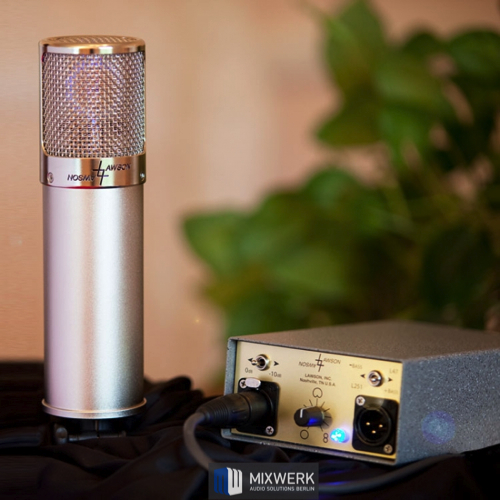
Type: tube microphone
Polar pattern: variable
Frequency response: 20 Hz to 20 kHz
Maximum SPL: 138 dB SPL
Self-noise level: 22 dB (A)
Price: c. 2,000 USD

Type: tube microphone
Polar pattern: variable
Frequency response: 20 Hz to 20 kHz
Maximum SPL: 138 dB SPL
Self-noise level: 22 dB (A)
Price: c. 2,000 USD
The L47 MP MKII is a rebirth and a new interpretation of the Neumann U47. It is a tube condenser microphone with a variable polar pattern, as well as a „cardioid-only“ mode, which increases the microphone's sensitivity and lowers the noise level by 3 dB. In multi-field mode the polar pattern can be varied from omnidirectional to figure of eight.
The capsule in the L47 is based on the legendary M7 capsule, which was originally used in U47 / U 48 microphones. In the original M7 capsule, however, a relatively thick PVC diaphragm was installed, whereas in the Lawson capsule a very thin three-micrometer mylar diaphragm is used. Along with the high-quality 6N1P tube, a Lundahl transfomer is used in the output circuit.
TELEFUNKEN RFT AK47
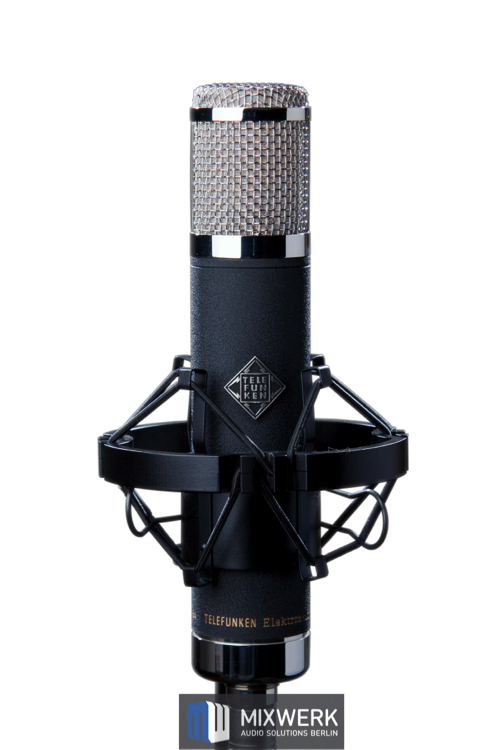
Type: large-diaphragm tube microphone
Polar pattern: variable
Frequency response: 20 Hz to 20 kHz
Maximum SPL: 125 dB SPL
Self-noise level: 10.5 dB (A)
Price: c. 2,000 USD

Type: large-diaphragm tube microphone
Polar pattern: variable
Frequency response: 20 Hz to 20 kHz
Maximum SPL: 125 dB SPL
Self-noise level: 10.5 dB (A)
Price: c. 2,000 USD
The R-F-T AK-47 MkII is a remarkable microphone with a character that is very present but not too hard; in many ways similar to its historical role models the M-49 and U-47/48. The result is a microphone with outstandingly detailed resolution in the higher frequency range and a dense and substantial bass range without the diffuse dip in the upper middle-frequency range, which one often encounters in microphones in this price range.
The amplifier used in the R-F-T AK-47 MkII incorporates a new proprietary circuit with an NOS-TELEFUNKEN EF-732 tube, as well as a special output transducer, with characteristics that are precisely replicated from the historical BV8 transducer used in the U-47 and U-48 microphones.
The Telefunken EF-732 tube bears a strong resemblance to the AC-701 tube with its soft satin character for the microphone's overall sound reproduction. When this tube is used together with the precise historical replica of the BV8 transducer, the result is a real tonal experience. The layout of the circuitry is specially designed to ensure the maximal signal to noise ratio, as well as minimal crosstalk between the components.
E.) Price category up to 3,000 USD
Manley Reference Cardioid
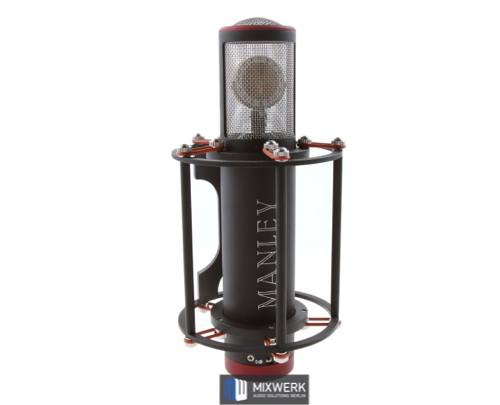
Type: tube microphone
Polar pattern:cardioid
Frequency response: 10 Hz to 30 kHz
Maximum SPL: 150 dB SPL
Price: c. 2,400 USD

Type: tube microphone
Polar pattern:cardioid
Frequency response: 10 Hz to 30 kHz
Maximum SPL: 150 dB SPL
Price: c. 2,400 USD
The Manley Reference Cardioid tube microphone has a triode tube circuit and a thick gold-coated capsule (6 microns). In its construction, its uniform high frequency resolution, an even close-talking effect and a very good pop and sibilant tolerance, this microphone is reminiscent of European vintage tube microphones like the U47. The gold diaphragm is of German origin and is tensioned using a proprietary technique developed by David Josephson, guaranteeing identical tolerance in each capsule. The result is a speed, lightness, airiness and reproduction of highs that cannot be found anywhere else.
For its calibrated tonal balance and the satin sound, this microphone is especially suited for vocals.
Neumann TLM 170
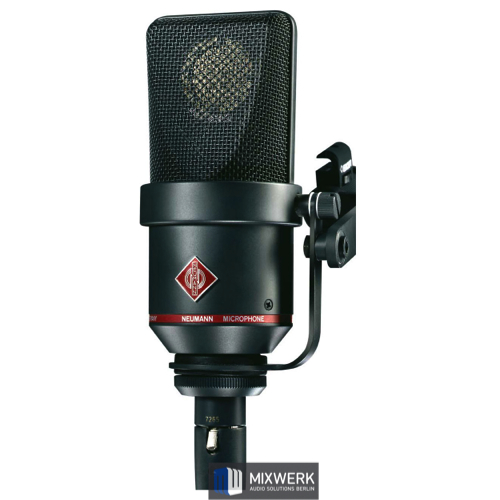
Type: large-diaphragm condenser microphone (pressure-gradient)
Polar pattern: variable
Frequency response: 20 Hz to 20 kHz
Maximum SPL: 154 dB SPL
SNR: 80 dB (1 kHz @ 1 Pa)
Price: c. 2,400 USD

Type: large-diaphragm condenser microphone (pressure-gradient)
Polar pattern: variable
Frequency response: 20 Hz to 20 kHz
Maximum SPL: 154 dB SPL
SNR: 80 dB (1 kHz @ 1 Pa)
Price: c. 2,400 USD
The TLM 170 was the first microphone with the FET-100 technology that has since proved so successful. It offers symmetrical transformerless signal decoupling and the highest modulation with extremely minimal self-noise.
One can switch between five polar patterns. In the sixth switch position, „R“, the polar pattern can be set remotely, via the power supply. The microphone additionally has a switchable 10 dB pre-attenuation for very high sound levels and a subsonic filter control with a working frequency of 100 Hz.
The dual-diaphragm capsule in the mesh grille of the microphone has especially even frequency responses for all available polar patterns. This is true not only, as is often the case, for sound incidence from the front, but also from the side. The microphone's impulse response is superb. It can faithfully transmit every kind of sound incident in both music and speech and is protected from mechanical vibration by an elastic suspension. It is used in a great variety of situations in radio, film and television.
Neumann U87 Ai
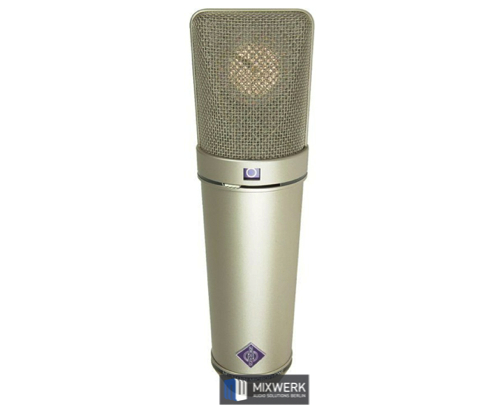
Type: large-diaphragm condenser microphone
Polar pattern: omnidirectional, cardioid, figure of eight
Frequency response: 20 Hz to 20kHz
Maximum SPL: 127 dB SPL
SNR: 82 dB (1 kHz @ 1 Pa cardioid)
Price: c. 2,400 USD

Type: large-diaphragm condenser microphone
Polar pattern: omnidirectional, cardioid, figure of eight
Frequency response: 20 Hz to 20kHz
Maximum SPL: 127 dB SPL
SNR: 82 dB (1 kHz @ 1 Pa cardioid)
Price: c. 2,400 USD
The U 87 Ai is equally well suited for many uses in the recording of sound for radio, television, film and in the studio. The frequency response is almost linear for the cardioid and figure of eight polar patterns, even in the higher frequency range with frontal sound incidence. The microphone can also be placed in close proximity to the sound source without an unnaturally sharp tone being produced.
A switch on the back operates a 10 dB pre-attenuation, which guarantees distortion-free reproduction up to sound pressure levels of 127 dB. The frequency response can further be dipped in the lower ranges, for example, to compensate for the close-talking effect.
The elastically suspended dual-diaphragm capsule is surrounded by a large wire mesh headgrille. A switch underneath the headgrille sets the polar pattern to omnidirectional, cardioid or figure of eight. The „A“ in the product name denotes an output that differs from that of the U 87 microphone that was available between 1967 and 1986. This change is in the electrical part of the microphone; it makes the U 87 more reliable due to a lower-resistance feed for the capsule bias, raises the transmission amount for the same amount of sound pressure by about 10 dB and improves the signal to noise ratio by 3 dB.
Schoeps V4 U

Type: small-diaphragm condenser microphone
Polar pattern: cardioid
Frequency response: 50 Hz to 22 kHz
Maximum SPL: 144 dB SPL
SNR: 79 dB(A)
Price: c. 2,400 USD

Type: small-diaphragm condenser microphone
Polar pattern: cardioid
Frequency response: 50 Hz to 22 kHz
Maximum SPL: 144 dB SPL
SNR: 79 dB(A)
Price: c. 2,400 USD
The V4 U is the studio vocal microphone from Schoeps. It combines the typical excellent technical features one expects from Schoeps with a timeless classical design.
The design of this cardioid microphone is derived from the CM 51/3, developed in 1951, but it is also uncompromisingly up-to-date: capsule, electronics and mechanics are all the result of painstaking new developments.
The V4 U does indeed have a small-diaphragm capsule architecture. The sound, however, is still warm and clear. In addition, a slight lift in the treble range frequency response produces brilliant highs.
Beesneez Arabella
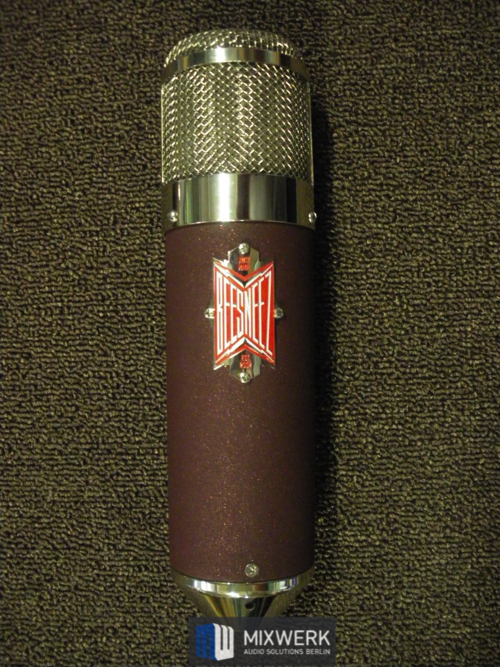
Type: tube condenser microphone
Polar pattern: multi-pattern
Frequency response: - Hz bis - kHz
Maximum SPL: - dB SPL
SNR: - dB (1 kHz @ 1 Pa)
Price: c. 2,700 USD

Type: tube condenser microphone
Polar pattern: multi-pattern
Frequency response: - Hz bis - kHz
Maximum SPL: - dB SPL
SNR: - dB (1 kHz @ 1 Pa)
Price: c. 2,700 USD
The Arabella is no clone, but a newly designed microphone built on the foundations of the honored U47 and M49. The components built into Arabella are only the finest, such as a hand-finished K47 capsule, a TELEFUNKEN 6SJ7 tube and a Cinemag 2461 NiCo transformer. The Arabella sounds open and intimate and this has led to its becoming a real favorite for both male and female voices.
Pearlman TM1
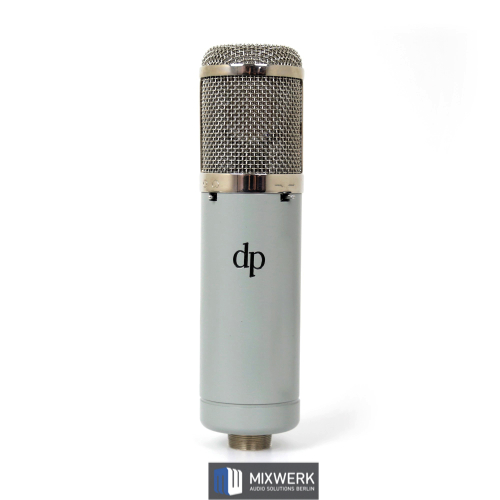
Type: tube microphone
Polar pattern: omnidirectional, cardioid
Frequency response: 20 Hz to 20 kHz
Price: c. 2,700 USD

Type: tube microphone
Polar pattern: omnidirectional, cardioid
Frequency response: 20 Hz to 20 kHz
Price: c. 2,700 USD
The Pearlman TM 1 has a large 6-micron diaphragm. The gold-coated capsule sends the input signal to a WWII TELEFUNKEN tube, which is nearly identical to the legendary VF14 tube. In addition, transformers from Cinemag or Tamura are installed.
The Pearlman TM 1 is no assembly-line microphone; every unit is wired and has its tension trimmed for high performance by hand. These microphones were originally made to the fill the need for high-quality tube microphones. They are now prized by everyone who hears their sound.
The Pearlman TM 1 offers the outstanding features of the prestigious Neumann U47 at about one-tenth of the price and receives especially high marks in recording vocals and speech, enabling even lighter voice tones to sound full.
Horch RM2J Mark 2

Type: tube microphone
Polar pattern: variable (omnidirectional, cardioid, figure of eight)
Price: c. 2,900 USD

Type: tube microphone
Polar pattern: variable (omnidirectional, cardioid, figure of eight)
Price: c. 2,900 USD
The Horch RM2J Mark 2 is a large-diaphragm tube microphone in the tradition of the classic tube microphones of the 1950s and 1960s. The RM2J Mark 2 offers a powerful sound and can be used in many situations, due to its variable polar patterns and two operational modes.
In linear mode one can switch the polar pattern continuously between omnidirectional, cardioid and figure of eight at the power supply. In this mode, the microphone operates with great linearity and is equally suited to all types of recording situations.
The vocal mode offers a special cardioid characteristic with a marked close-talking effect as compared to the cardioid characteristic in the linear mode and can thus boost the human voice to the desired larger-than-life sound.
F.) Price category up to 5,000 USD
Audio-Technica 5040
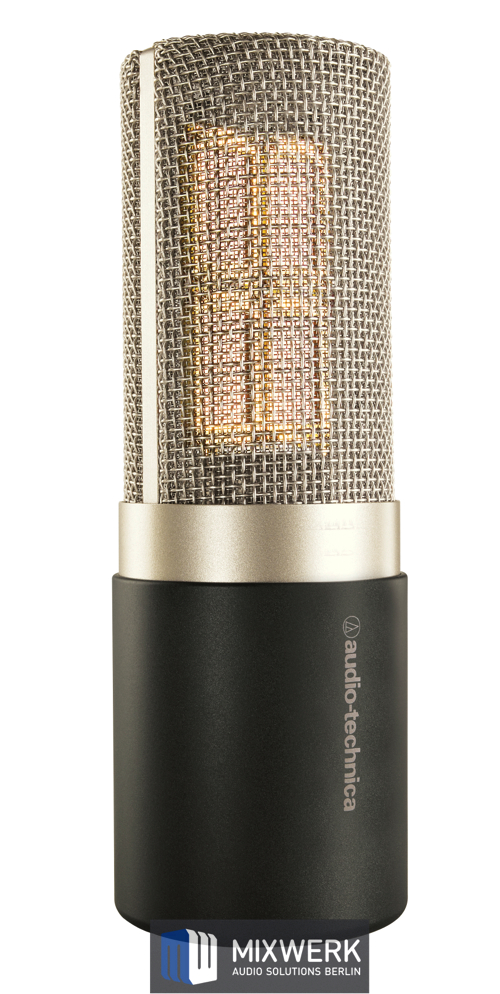
Type: large-diaphragm condenser microphone
Polar pattern: cardioid
Frequency response: 20 Hz to 20 kHz
SPL max: 142 dBSPL
SNR: 89 dB (1 kHz @ 1 Pa)
Price: c. 3,100 USD

Type: large-diaphragm condenser microphone
Polar pattern: cardioid
Frequency response: 20 Hz to 20 kHz
SPL max: 142 dBSPL
SNR: 89 dB (1 kHz @ 1 Pa)
Price: c. 3,100 USD
The AT5040 condenser microphone with cardioid polar pattern is conceived as a studio vocals microphone. The microphone offers an extremely smooth sound in the trebles with controlled sibilants. It delivers an unusually musical and faithful reproduction, penetrant real proximity and presence, depth and clarity of tone. By using four diaphragms in one capsule, the AT5040 benefits from all the advantages of an unusually large diaphragm with an extremely low noise floor, while having no pro0blems with increased weight and decreased impulse response or other disadvantages that typically limit the size of the diaphragm.
Neumann U47 FET
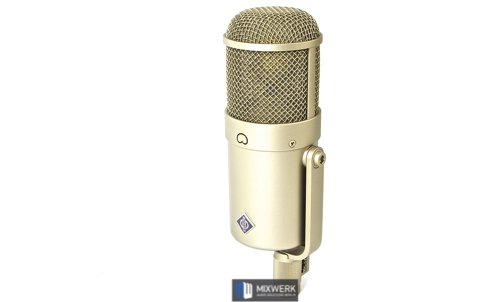
Type: large-diaphragm condenser microphone
Polar pattern: cardioid
Frequency response: 40 Hz to 16kHz
Maximum SPL: 147 dB SPL
SNR: 76 dB (1 kHz @ 1 Pa)
Price: c. 3,800 USD

Type: large-diaphragm condenser microphone
Polar pattern: cardioid
Frequency response: 40 Hz to 16kHz
Maximum SPL: 147 dB SPL
SNR: 76 dB (1 kHz @ 1 Pa)
Price: c. 3,800 USD
The U 47 FET was first manufactured between 1972 and 1986 and ever since has secured a permanent place among the microphones used by many prestigious studios. From a technical standpoint, the U 47 FET is a condenser microphone with a cardioid polar pattern and the FET 80 switching circuit.
This is also used in, among others, the U 87 and is particularly noted for its high output capability. The dual-diaphragm K 47 capsule was already used in the legendary tube-based predecessor, the U 47 and has a light lift in presence above the 2 kHz range. A switchable high pass filter can, if desired, raise the low electrical frequency limit from 40 Hz to 140 Hz, thus suppressing undesired low frequencies (impact noise, wind sounds) or serves to compensate for the close-talking effect. The switchable attenuation reduces the sensitivity level by 10 dB and enables processing of very high sound pressure up to 147 dB. In addition, in order to prevent an overload of the attached preamp, the output signal can be lowered by 6 dB with a switch on the underside of the microphone.
Blue Microphones - The Bottle
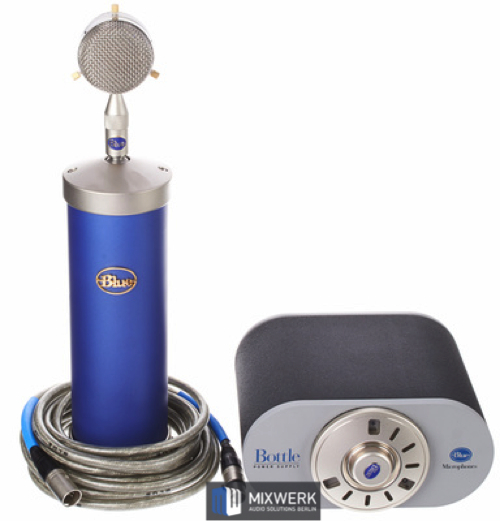
Type: tube microphone
Polar pattern: variable
Frequency response: 20 Hz to 20 kHz
SMaximum SPL: 134 dB SPL
SNR: 86.5 dB (1 kHz @ 1 Pa)
Price: c. 3,900 USD

Type: tube microphone
Polar pattern: variable
Frequency response: 20 Hz to 20 kHz
SMaximum SPL: 134 dB SPL
SNR: 86.5 dB (1 kHz @ 1 Pa)
Price: c. 3,900 USD
„The Bottle“ combines low noise and excellent impulse response. Alternation between the eight different capsules that can be used with this microphone system is speedy, making it easy to set for different sound features and polar patterns.
The discrete Class A amp switch has a modern design that pays tribute to the past, characterized by the installation of a hand-selected EF86 pentode vacuum tube. The microphone performs superbly for speech recording, especially with the B6 large-diaphragm capsule.
Brauner VM1
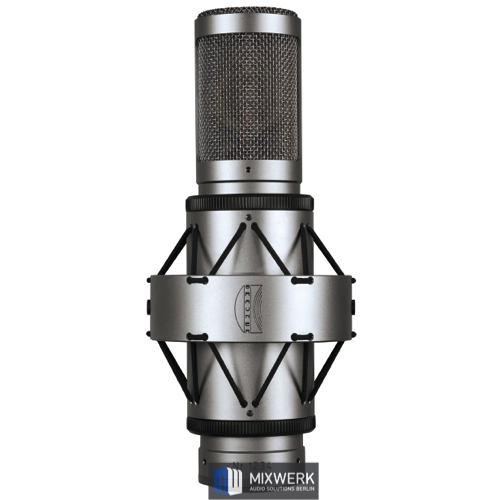
Type: tube large-diaphragm microphone
Polar pattern: variable
Frequency response: 18 Hz to 24 kHz
Maximum SPL: 142 dB SPL
SNR: 83 dB (1 kHz @ 1 Pa)
Price: c. 4,200 USD

Type: tube large-diaphragm microphone
Polar pattern: variable
Frequency response: 18 Hz to 24 kHz
Maximum SPL: 142 dB SPL
SNR: 83 dB (1 kHz @ 1 Pa)
Price: c. 4,200 USD
The Brauner VM1 is especially characterized by its natural and modern sound with the highest resolution of acoustic detail. Its transparent, open tone is equally suited to both vocals and instrumental recording. The VM 1 was developed as a kind of „Swiss Army Knife“ for the most varied of recording situations.
Whenever voices of any kind are to be recorded, the Brauner is the first choice among tube microphones. In particular, the Brauner can record „complicated“ male voices in such a smooth manner as to make any later processing almost completely redundant. One should, however, always use the Brauner in combination with a high-quality preamp to enable it to realize its full, classy potential. The VM 1 is also available in a lower-price model with a fixed cardioid polar pattern. Anyone aiming to use the Brauner exclusively as a voice-over microphone can save about 900 USD with the „pure cardioid“ version.
G.) Price category up to 10,000 USD
Wunder Audio CM7 FET
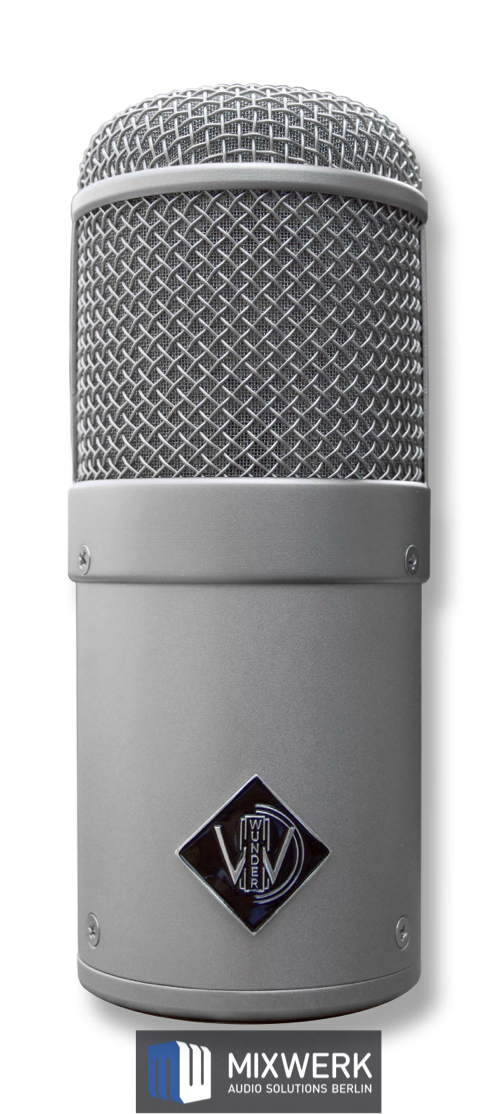
Type: large-diaphragm condenser microphone (FET)
Polar pattern: cardioid
Price: c. 6,500 USD

Type: large-diaphragm condenser microphone (FET)
Polar pattern: cardioid
Price: c. 6,500 USD
A „phantom powered“ version of the original U47 was released in 1969 as the U47 FET. The circuitry and the robust sound produced by transistors were much prized. The FET variant of the U47 was, since its inception, one of the preferred microphones due to its „larger than life“ sound, especially beneficial when recording the human voice.
The components used in the Wunder CM7 FET are as close as possible to those in the original. In addition, an exact copy of the original grille is one of the most important features that contribute to the recreation of the legendary sound of the U47.
Bock 507
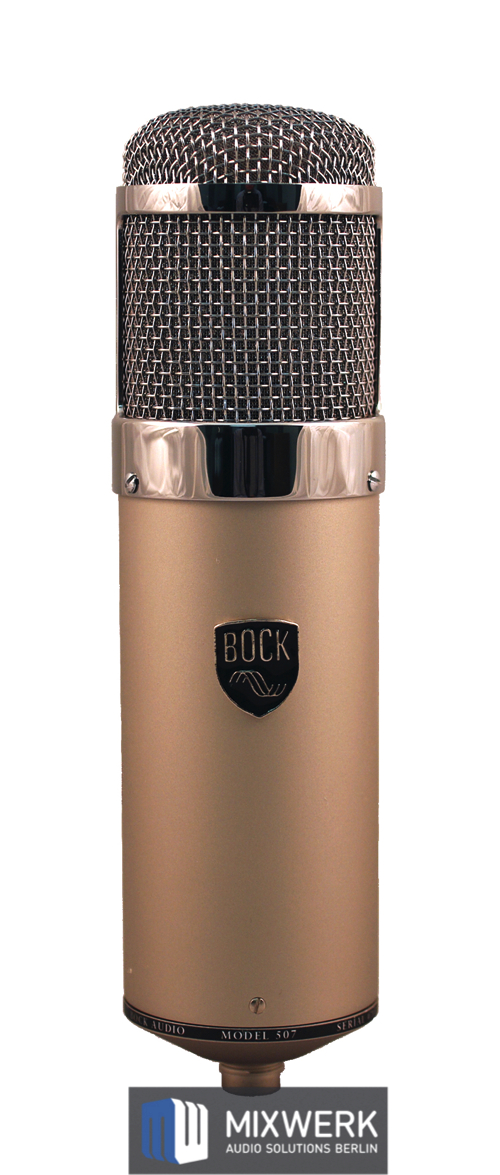
Type: large-diaphragm tube microphone
Polar pattern: cardioid
Frequency response: 20 Hz to 20 kHz
Maximum SPL:- dBSPL
SNR: - dB (1 kHz @ 1 Pa)
Price: c. 7,500 USD

Type: large-diaphragm tube microphone
Polar pattern: cardioid
Frequency response: 20 Hz to 20 kHz
Maximum SPL:- dBSPL
SNR: - dB (1 kHz @ 1 Pa)
Price: c. 7,500 USD
Conceived as a studio vocals microphone, the 507 must be considered as one of the best microphones in the world. A special feature is the elliptical capsule with dual-diaphragm. This so-called „golden ellipsoid“ capsule solves the problem of in-band resonance, which is common to large-diaphragm and small-diaphragm microphones. The tube amplification is based on the circuitry of the legendary U47. The microphone has a big sound and delivers a painstakingly developed close-talking effect. A low self-noise level and high end microphone sound are additional points in its favor.
Sony C-800G Tube Mic
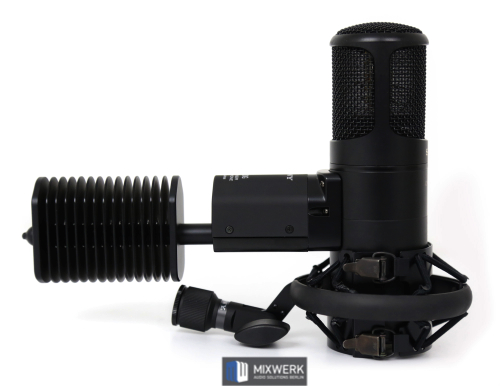
Type: large-diaphragm tube condenser microphone
Polar pattern: cardioid, omnidirectional
Frequency response: 20 Hz to 18 kHz
Maximum SPL: 131 dB SPL
SNR: 76 dB (1 kHz @ 1 Pa)
Price: c. 8,800 USD

Type: large-diaphragm tube condenser microphone
Polar pattern: cardioid, omnidirectional
Frequency response: 20 Hz to 18 kHz
Maximum SPL: 131 dB SPL
SNR: 76 dB (1 kHz @ 1 Pa)
Price: c. 8,800 USD
Sony developed the C-800G tube condenser microphone in order to be able to capture the full dynamic range of sound sources and their most delicate nuances. Its natural sound makes it a favorite in film post-production.
High-quality vacuum tubes and an innovative cooling system help the C-800G to offer a warm, natural and powerful sound with little noise and only minimal distortion. This microphone's special significance lies in its outstandingly natural sound.
TELEFUNKEN U47/U48
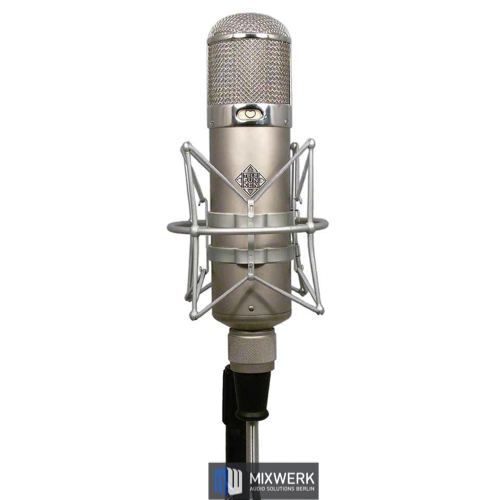
Type: large-diaphragm tube microphone
Polar pattern: cardiod and omnidirectional
Frequency response: 20 Hz to 20 kHz
Maximum SPL: 127 dB SPL
Self-noise level: 9 dB (A)
Price: c. 9,500 USD

Type: large-diaphragm tube microphone
Polar pattern: cardiod and omnidirectional
Frequency response: 20 Hz to 20 kHz
Maximum SPL: 127 dB SPL
Self-noise level: 9 dB (A)
Price: c. 9,500 USD
For several generations, since it was originally developed in 1946, the TELEFUNKEN U 47 has been the microphone of choice for recording professionals. As the first condenser microphone with a polar pattern switchable between cardioid and omnidirectional, the original U 47 also includes the famous M7 capsule, which had already been developed by Georg Neumann in 1928.
To this capsule was added an amplifier based on VF-14 tubes (which originated in military technology and had been used in operational and aircraft radios) and a BV8 output transducer. The introduction of the U 47 lifted the audio world up to a hitherto unknown level of tonal fidelity, which is why it is still considered to be one of the best microphones ever manufactured.
The „family resemblance“ of TELEFUNKEN's U 47 can be seen at a first glance. The large microphone head with chrome grille includes a newly produced M7 capsule. The body of the microphone, with a matte nickel finish, includes a new BV8 output transducer and a new VF-14 vacuum tube; a „plug and play“ replacement for the very rare VF-14M tubes of the original. TELEFUNKEN's classic diamond logo adorns the front of the microphone body.
Regardless of whether it is a symphony orchestra, a singer or a piece of contemporary music that must be recorded, the U 47 proves itself a superb piece of recording equipment. The marked middle range and the expanded impulse response in the low ranges give this microphone its unmistakable character.
Stay Informed
When you subscribe to the blog, we will send you an e-mail when there are new updates on the site so you wouldn't miss them.

Comments